stat841: Difference between revisions
| Line 2,026: | Line 2,026: | ||
\end{matrix}\right] </math> is the matrix of weights. | \end{matrix}\right] </math> is the matrix of weights. | ||
Here, <math>k</math> is the number of classifiers, <math>n</math> is the number of data points, and <math>M</math> is the number of hidden units. If <math>k = | Here, <math>k</math> is the number of classifiers, <math>n</math> is the number of data points, and <math>M</math> is the number of hidden units. If <math>k = 2</math>, <math>\hat Y</math> and <math>W</math> are <math>n \times 2</math>. As input <math>\,Y</math> is usually the class of 1 or 2 rather than probability of each class, to match with <math>\hat Y</math> make <math>Y_{i1} = 1</math> if <math>Y_i = 1</math>, <math>Y_{i2} = 1</math> if <math>Y_i = 2</math>. | ||
=== Estimation of weight matrix W === | === Estimation of weight matrix W === | ||
Revision as of 14:24, 13 November 2009
Proposal
Mark your contribution here
Scribe sign up
Classfication-2009.9.30
Classification
With the rise of fields such as data-mining, bioinformatics, and machine learning, classification has becomes a fast-developing topic. In the age of information, vast amounts of data are generated constantly, and the goal of classification is to learn from data. Potential application areas include handwritten post codes recognition, medical diagnosis, face recognition, human language processing and so on.
Definition: The problem of Prediction a discrete random variable [math]\displaystyle{ \mathcal{Y} }[/math] from another random variable [math]\displaystyle{ \mathcal{X} }[/math] is called Classification.
In classification,, we attempt to approximate a function [math]\displaystyle{ \,h }[/math], by using a training data set, which will then be able to accurately classify new data inputs.
Given [math]\displaystyle{ \mathcal{X} \subset \mathbb{R}^{d} }[/math], a subset of the [math]\displaystyle{ d }[/math]-dimensional real vectors and [math]\displaystyle{ \mathcal{Y} }[/math], a finite set of labels, We try to determine a 'classification rule' [math]\displaystyle{ \,h }[/math] such that,
- [math]\displaystyle{ \,h: \mathcal{X} \mapsto \mathcal{Y} }[/math]
We use [math]\displaystyle{ \,n }[/math] ordered pairs of training data which are identical independent distributions, [math]\displaystyle{ \,\{(X_{1},Y_{1}), (X_{2},Y_{2}), \dots , (X_{n},Y_{n})\} }[/math] where [math]\displaystyle{ \,X_{i} \in \mathcal{X} }[/math],[math]\displaystyle{ \,Y_{i} \in \mathcal{Y} }[/math], to approximate [math]\displaystyle{ \,h }[/math].
Thus, given a new input, [math]\displaystyle{ \,X \in \mathcal{X} }[/math]
by using the classification rule we can predict a corresponding [math]\displaystyle{ \,\hat{Y}=h(X) }[/math].
- Example Suppose we wish to classify fruits into apples and oranges by considering certain features of the fruit, for instance, color, diameter, and weight.
Let [math]\displaystyle{ \mathcal{X}= (\mathrm{colour}, \mathrm{diameter}, \mathrm{weight}) }[/math] and [math]\displaystyle{ \mathcal{Y}=\{\mathrm{apple}, \mathrm{orange}\} }[/math]. The goal is to find a classification rule such that when a new fruit [math]\displaystyle{ \,X }[/math] is presented based on its features, [math]\displaystyle{ (\,X_{\mathrm{color}}, X_{\mathrm{diameter}}, X{_\mathrm{weight}}) }[/math], our classification rule [math]\displaystyle{ \,h }[/math] can classify it as either an apple or an orange, i.e., [math]\displaystyle{ \,h(X_{\mathrm{color}}, X_{\mathrm{diameter}}, X_{\mathrm{weight}}) }[/math] be the fruit type of [math]\displaystyle{ \,X }[/math].
Error rate
- 'True error rate' of a classifier(h) is defined as the probability that [math]\displaystyle{ \,h }[/math] does not correctly classify the points of [math]\displaystyle{ \,\mathcal{X} }[/math], i.e.,
- [math]\displaystyle{ \, L(h)=P(h(X) \neq Y) }[/math]
- 'Empirical error rate(training error rate)' of a classifier(h) is defined as the frequency that [math]\displaystyle{ \,h }[/math] does not correctly classify the points in the training set, i.e.,
- [math]\displaystyle{ \, L_{h}= \frac{1}{n} \sum_{i=1}^{n} I(h(X_{i}) \neq Y_{i}) }[/math], where [math]\displaystyle{ \,I }[/math] is an indicator that [math]\displaystyle{ \, I= \left\{\begin{matrix} 1 & h(X_i) \neq Y_i \\ 0 & h(X_i)=Y_i \end{matrix}\right. }[/math].
Bayes Classifier
The principle of Bayes Classifier is to calculate the posterior probability of a given object from its prior probability via Bayes formula, and then place the object in the class with the largest posterior probability. Intuitively speaking, to classify [math]\displaystyle{ \,x\in \mathcal{X} }[/math] we find [math]\displaystyle{ y \in \mathcal{Y} }[/math] such that [math]\displaystyle{ \,P(Y=y|X=x) }[/math] is maximum over all the members of [math]\displaystyle{ \mathcal{Y} }[/math].
Mathematically, for [math]\displaystyle{ \,k }[/math] classes and given object [math]\displaystyle{ \,X=x }[/math], we find [math]\displaystyle{ \,y\in \mathcal{Y} }[/math] which maximizes [math]\displaystyle{ \,P(Y=y|X=x) }[/math], and classify [math]\displaystyle{ \,X }[/math] into class [math]\displaystyle{ \,y }[/math]. In order to calculate the value of [math]\displaystyle{ \,P(Y=y|X=x) }[/math], we use Bayes formula
- [math]\displaystyle{ \begin{align} P(Y=y|X=x) &= \frac{P(X=x|Y=y)P(Y=y)}{P(X=x)} \\ &=\frac{P(X=x|Y=y)P(Y=y)}{\Sigma_{\forall y \in \mathcal{Y}}P(X=x|Y=y)P(Y=y)} \end{align} }[/math]
where [math]\displaystyle{ \,P(Y=y|X=x) }[/math] is referred to as the posterior probability, [math]\displaystyle{ \,P(Y=y) }[/math] as the prior probability, [math]\displaystyle{ \,P(X=x|Y=y) }[/math] as the likelihood, and [math]\displaystyle{ \,P(X=x) }[/math] as the evidence.
For the special case that [math]\displaystyle{ \,Y }[/math] has only two classes, that is, [math]\displaystyle{ \, \mathcal{Y}=\{0, 1\} }[/math]. Consider the probability that [math]\displaystyle{ \,r(X)=P\{Y=1|X=x\} }[/math]. Given [math]\displaystyle{ \,X=x }[/math], By Bayes formula, we have
- [math]\displaystyle{ \begin{align} r(X)&=P(Y=1|X=x) \\ &=\frac{P(X=x|Y=1)P(Y=1)}{P(X=x)}\\ &=\frac{P(X=x|Y=1)P(Y=1)}{P(X=x|Y=1)P(Y=1)+P(X=x|Y=0)P(Y=0)} \end{align} }[/math]
Definition:
The Bayes classification rule [math]\displaystyle{ \,h }[/math] is
- [math]\displaystyle{ \, h(X)= \left\{\begin{matrix} 1 & r(x)\gt \frac{1}{2} \\ 0 & \mathrm{otherwise} \end{matrix}\right. }[/math]
3 different approaches to classification:
1) Empirical Risk Minimization: Choose a set fo classifier [math]\displaystyle{ \mathcal{H} }[/math] and find [math]\displaystyle{ \,h^*\in \mathcal{H} }[/math] that minimizes some estimate of [math]\displaystyle{ \,L(h) }[/math]
2) Regression: Find an estimate [math]\displaystyle{ (\hat r) }[/math] of the function [math]\displaystyle{ r }[/math] and deifne
- [math]\displaystyle{ \, h(X)= \left\{\begin{matrix} 1 & \hat r(x)\gt \frac{1}{2} \\ 0 & \mathrm{otherwise} \end{matrix}\right. }[/math]
3) Density Estimation: estimate [math]\displaystyle{ \,P(X=x|Y=0) }[/math] and [math]\displaystyle{ \,P(X=x|Y=1) }[/math] (less popular in high-dimension cases)
Bayes Classification Rule Optimality Theorem: The Bayes rule is optimal in true error rate, that is for any other classification rule [math]\displaystyle{ \, \overline{h} }[/math], we have [math]\displaystyle{ \,L(h) \le L(\overline{h}) }[/math]. Intuitively speaking this theorem is saying we cannot do better than classifying [math]\displaystyle{ \,x\in \mathcal{X} }[/math] to [math]\displaystyle{ \,y }[/math] when[math]\displaystyle{ }[/math] the probability of being of type [math]\displaystyle{ \,y }[/math] for [math]\displaystyle{ \,x }[/math] is more than probability of being any other type.
Definition:
The set [math]\displaystyle{ \,D(h)=\{x: P(Y=1|X=x)=P(Y=0|X=x)\} }[/math] is called the decision boundary.
- [math]\displaystyle{ \, h^*(X)= \left\{\begin{matrix} 1 & if P(Y=1|X=x)\gt P(Y=0|X=x) \\ 0 & \mathrm{otherwise} \end{matrix}\right. }[/math]
Remark:
1)Bayes classification rule is optimal. Proof:[1]
2)We still need any other method, since we cannot define prior probability in realistic.
Example:
We’re going to predict if a particular student will pass STAT441/841.
We have data on past student performance. For each student we know:
If student’s GPA > 3.0 (G)
If student had a strong math background (M)
If student is a hard worker (H)
If student passed or failed course
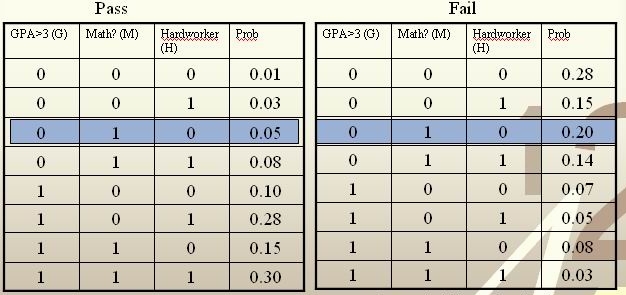
[math]\displaystyle{ \, \mathcal{Y}= \{ 0,1 \} }[/math], where 1 refers to pass and 0 refers to fail. Assume that [math]\displaystyle{ \,P(Y=1)=P(Y=0)=0.5 }[/math]
For a new student comes along with values [math]\displaystyle{ \,G=0, M=1, H=0 }[/math], we calculate [math]\displaystyle{ \,r(X)=P(Y=1|X=(0,1,0)) }[/math] as
[math]\displaystyle{ \,r(X)=P(Y=1|X=(0,1,0))=\frac{P(X=(0,1,0)|Y=1)P(Y=1)}{P(X=(0,1,0)|Y=1)P(Y=1)+P(X=(0,1,0)|Y=0)P(Y=0)}=\frac{0.025}{0.125}=0.2\lt \frac{1}{2} }[/math]
Thus, we classify the new student into class 0, namely, we predict him to fail in this course.
- Notice: Although the Bayes rule is optimal, we still need other methods, since it is generally impossible for us to know the prior [math]\displaystyle{ \,P(Y=1) }[/math], and class conditional density [math]\displaystyle{ \,P(X=x|Y=1) }[/math] and ultimately calculate the value of [math]\displaystyle{ \,r(X) }[/math], which makes Bayes rule inconvenient in practice.
Currently, there are four primary classifier based on Bayes Classifier: Naive Bayes classifier[2], tree-augmented naive Bayes (TAN), Bayesian network augmented naive Bayes (BAN) and general Bayesian network (GBN).
useful link:Decision Theory, Bayes Classifier
Bayesian vs. Frequentist
Intuitively, to solve a two-class problem, we may have the following two approaches:
1) If [math]\displaystyle{ \,P(Y=1|X=x)\gt P(Y=0|X=x) }[/math], then [math]\displaystyle{ \,h(x)=1 }[/math], otherwise [math]\displaystyle{ \,h(x)=0 }[/math].
2) If [math]\displaystyle{ \,P(X=x|Y=1)\gt P(X=x|Y=0) }[/math], then [math]\displaystyle{ \,h(x)=1 }[/math], otherwise [math]\displaystyle{ \,h(x)=0 }[/math].
One obvious difference between these two methods is that the first one considers probability as changing based on observation while the second one considers probablity as having objective existence. Actually, they represent two different schools in statistics.
During the history of statistics, there are two major classification methods : Bayesian and frequentist. The two methods represent two different ways of thoughts and hold different view to define probability. The followings are the main differences between Bayes and Frequentist.
Frequentist
- Probability is objective.
- Data is a repeatable random sample(there is a frequency).
- Parameters are fixed and unknown constant.
- Not applicable to single event. For example, a frequentist cannot predict the weather of tomorrow because tomorrow is only one unique event, and cannot be referred to a frequency in a lot of samples.
Bayesian
- Probability is subjective.
- Data are fixed.
- Parameters are unknown and random variables that have a given distribution and other probability statements can be made about them.
- Can be applied to single events based on degree of confidence or beliefs. For example, Bayesian can predict tomorrow's weather, such as having the probability of [math]\displaystyle{ \,50% }[/math] of rain.
Example
Suppose there is a man named Jack. In Bayesian method, at first, one can see this man (object), and then judge whether his name is Jack (label). On the other hand, in Frequentist method, one doesn’t see the man (object), but can see the photos (label) of this man to judge whether he is Jack.
Linear and Quadratic Discriminant Analysis - October 2,2009
Introduction
Notation
Let us first introduce some new notation for the following sections.
Multi-class Classification:
Y takes on more than two values.
Recall that in the discussion of the Bayes Classifier, we introduced Bayes Formula:
- [math]\displaystyle{ \begin{align} P(Y=y|X=x) &=\frac{P(X=x|Y=y)P(Y=y)}{\Sigma_{\forall y \in \mathcal{Y}}P(X=x|Y=y)P(Y=y)} \end{align} }[/math]
We will use new labels for the following equivalent formula:
- [math]\displaystyle{ \begin{align} P(Y=k|X=x) &=\frac{f_k(x)\pi_k}{\Sigma_kf_k(x)\pi_k} \end{align} }[/math]
- [math]\displaystyle{ \,f_k }[/math] is called the class conditional density; also referred to previously as the likelihood function. Essentially, this is the function that allows us to reason about a parameter given a certain outcome.
- [math]\displaystyle{ \,\pi_k }[/math] is called the prior probability. This is a probability distribution that represents what we know (or believe we know) about a population.
- [math]\displaystyle{ \,\Sigma_k }[/math] is the sum with respect to all [math]\displaystyle{ \,k }[/math] classes.
Theorem: Suppose that [math]\displaystyle{ \,Y \in \mathcal{Y}= \{1,\dots,k\} }[/math], the optimal rule is :[math]\displaystyle{ \,h^*(X) = \arg\max_{k}{P(Y = k|X = x)} }[/math]
Approaches
Representing the optima method, Bayes classifier cannot be used in most practical situations though, since usually the prior probability is unknown. Fortunately, other methods of classification have evolved. These methods fall into three general categories.
1 Empirical Risk Minimization:Choose a set fo classifier [math]\displaystyle{ \mathcal{H} }[/math] and find [math]\displaystyle{ \,h^* \epsilon H }[/math], minimize some estimate of [math]\displaystyle{ \,L(H) }[/math].
2 Regression:Find an estimate [math]\displaystyle{ (\hat r) }[/math] of the function [math]\displaystyle{ r }[/math] and deifne
- [math]\displaystyle{ \, h(X)= \left\{\begin{matrix} 1 & \hat r(x)\gt \frac{1}{2} \\ 0 & \mathrm{otherwise} \end{matrix}\right. }[/math]
3 Density estimation, estimate [math]\displaystyle{ P(X = x|Y = 0) }[/math] and [math]\displaystyle{ P(X = x|Y = 1) }[/math]
The third approach, in this form, is not popular because density estimation doesn't work very well with dimension greater than 2. Linear Discriminate Analysis and Quadratic Discriminate Analysis are examples of the third approach, density estimation.
LDA
Motivation
The Bayes classifier is optimal. Unfortunately, the prior and conditional density of most data is not known. Some estimation of these should be made if we want to classify some data.
The simplest way to achieve this is to assume that all the class densities are approximately a multivariate normal distribution, find the parameters of each such distribution, and use them to calculate the conditional density and prior for unknown points, thus approximating the Bayesian classifier to choose the most likely class. In addition, if the covariance of each class density is assumed to be the same, the number of unknown parameters is reduced and the model is easy to fit and use, as seen later.
History
The name Linear Discriminant Analysis comes from the fact that these simplifications produce a linear model, which is used to discriminate between classes. In many cases, this simple model is sufficient to provide a near optimal classification - for example, the Z-Score credit risk model, designed by Edward Altman in 1968, which is essentially a weighted LDA, revisited in 2000, has shown an 85-90% success rate predicting bankruptcy, and is still in use today.
Definition
To perform LDA we make two assumptions.
- The clusters belonging to all classes each follow a multivariate normal distribution.
[math]\displaystyle{ x \in \mathbb{R}^d }[/math] [math]\displaystyle{ f_k(x)=\frac{1}{ (2\pi)^{d/2}|\Sigma_k|^{1/2} }\exp\left( -\frac{1}{2} [x - \mu_k]^\top \Sigma_k^{-1} [x - \mu_k] \right) }[/math] - Each cluster has the same variance [math]\displaystyle{ \,\Sigma }[/math] equal to the mean variance of [math]\displaystyle{ \Sigma_k \forall k }[/math].
We wish to solve for the boundary where the error rates for classifying a point are equal, where one side of the boundary gives a lower error rate for one class and the other side gives a lower error rate for the other class.
So we solve [math]\displaystyle{ \,r_k(x)=r_l(x) }[/math] for all the pairwise combinations of classes.
[math]\displaystyle{ \,\Rightarrow Pr(Y=k|X=x)=Pr(Y=l|X=x) }[/math]
[math]\displaystyle{ \,\Rightarrow \frac{Pr(X=x|Y=k)Pr(Y=k)}{Pr(X=x)}=\frac{Pr(X=x|Y=l)Pr(Y=l)}{Pr(X=x)} }[/math] using Bayes' Theorem
[math]\displaystyle{ \,\Rightarrow Pr(X=x|Y=k)Pr(Y=k)=Pr(X=x|Y=l)Pr(Y=l) }[/math] by canceling denominators
[math]\displaystyle{ \,\Rightarrow f_k(x)\pi_k=f_l(x)\pi_l }[/math]
[math]\displaystyle{ \,\Rightarrow \frac{1}{ (2\pi)^{d/2}|\Sigma|^{1/2} }\exp\left( -\frac{1}{2} [x - \mu_k]^\top \Sigma^{-1} [x - \mu_k] \right)\pi_k=\frac{1}{ (2\pi)^{d/2}|\Sigma|^{1/2} }\exp\left( -\frac{1}{2} [x - \mu_l]^\top \Sigma^{-1} [x - \mu_l] \right)\pi_l }[/math]
[math]\displaystyle{ \,\Rightarrow \exp\left( -\frac{1}{2} [x - \mu_k]^\top \Sigma^{-1} [x - \mu_k] \right)\pi_k=\exp\left( -\frac{1}{2} [x - \mu_l]^\top \Sigma^{-1} [x - \mu_l] \right)\pi_l }[/math] Since both [math]\displaystyle{ \Sigma }[/math] are equal based on the assumptions specific to LDA.
[math]\displaystyle{ \,\Rightarrow -\frac{1}{2} [x - \mu_k]^\top \Sigma^{-1} [x - \mu_k] + \log(\pi_k)=-\frac{1}{2} [x - \mu_l]^\top \Sigma^{-1} [x - \mu_l] +\log(\pi_l) }[/math] taking the log of both sides.
[math]\displaystyle{ \,\Rightarrow \log(\frac{\pi_k}{\pi_l})-\frac{1}{2}\left( x^\top\Sigma^{-1}x + \mu_k^\top\Sigma^{-1}\mu_k - 2x^\top\Sigma^{-1}\mu_k - x^\top\Sigma^{-1}x - \mu_l^\top\Sigma^{-1}\mu_l + 2x^\top\Sigma^{-1}\mu_l \right)=0 }[/math] by expanding out
[math]\displaystyle{ \,\Rightarrow \log(\frac{\pi_k}{\pi_l})-\frac{1}{2}\left( \mu_k^\top\Sigma^{-1}\mu_k-\mu_l^\top\Sigma^{-1}\mu_l - 2x^\top\Sigma^{-1}(\mu_k-\mu_l) \right)=0 }[/math] after canceling out like terms and factoring.
We can see that this is a linear function in x with general form [math]\displaystyle{ \,ax+b=0 }[/math].
Actually, this linear log function shows that the decision boundary between class [math]\displaystyle{ k }[/math] and class [math]\displaystyle{ l }[/math], i.e. [math]\displaystyle{ Pr(G=k|X=x)=Pr(G=l|X=x) }[/math], is linear in [math]\displaystyle{ x }[/math]. Given any pair of classes, decision boundaries are always linear. In [math]\displaystyle{ p }[/math] dimensions, we separate regions by hyperplanes.
In the special case where the number of samples from each class are equal ([math]\displaystyle{ \,\pi_k=\pi_l }[/math]), the boundary surface or line lies halfway between [math]\displaystyle{ \,\mu_l }[/math] and [math]\displaystyle{ \,\mu_k }[/math]
QDA
The concept is the same idea of finding a boundary where the error rate for classification between classes are equal, except the assumption that each cluster has the same variance [math]\displaystyle{ \,\Sigma }[/math] equal to the mean variance of [math]\displaystyle{ \Sigma_k \forall k }[/math] is removed.
Following along from where QDA diverges from LDA.
[math]\displaystyle{ \,f_k(x)\pi_k=f_l(x)\pi_l }[/math]
[math]\displaystyle{ \,\Rightarrow \frac{1}{ (2\pi)^{d/2}|\Sigma_k|^{1/2} }\exp\left( -\frac{1}{2} [x - \mu_k]^\top \Sigma_k^{-1} [x - \mu_k] \right)\pi_k=\frac{1}{ (2\pi)^{d/2}|\Sigma_l|^{1/2} }\exp\left( -\frac{1}{2} [x - \mu_l]^\top \Sigma_l^{-1} [x - \mu_l] \right)\pi_l }[/math]
[math]\displaystyle{ \,\Rightarrow \frac{1}{|\Sigma_k|^{1/2} }\exp\left( -\frac{1}{2} [x - \mu_k]^\top \Sigma_k^{-1} [x - \mu_k] \right)\pi_k=\frac{1}{|\Sigma_l|^{1/2} }\exp\left( -\frac{1}{2} [x - \mu_l]^\top \Sigma_l^{-1} [x - \mu_l] \right)\pi_l }[/math] by cancellation
[math]\displaystyle{ \,\Rightarrow -\frac{1}{2}\log(|\Sigma_k|)-\frac{1}{2} [x - \mu_k]^\top \Sigma_k^{-1} [x - \mu_k]+\log(\pi_k)=-\frac{1}{2}\log(|\Sigma_l|)-\frac{1}{2} [x - \mu_l]^\top \Sigma_l^{-1} [x - \mu_l]+\log(\pi_l) }[/math] by taking the log of both sides
[math]\displaystyle{ \,\Rightarrow \log(\frac{\pi_k}{\pi_l})-\frac{1}{2}\log(\frac{|\Sigma_k|}{|\Sigma_l|})-\frac{1}{2}\left( x^\top\Sigma_k^{-1}x + \mu_k^\top\Sigma_k^{-1}\mu_k - 2x^\top\Sigma_k^{-1}\mu_k - x^\top\Sigma_l^{-1}x - \mu_l^\top\Sigma_l^{-1}\mu_l + 2x^\top\Sigma_l^{-1}\mu_l \right)=0 }[/math] by expanding out
[math]\displaystyle{ \,\Rightarrow \log(\frac{\pi_k}{\pi_l})-\frac{1}{2}\log(\frac{|\Sigma_k|}{|\Sigma_l|})-\frac{1}{2}\left( x^\top(\Sigma_k^{-1}-\Sigma_l^{-1})x + \mu_k^\top\Sigma_k^{-1}\mu_k - \mu_l^\top\Sigma_l^{-1}\mu_l - 2x^\top(\Sigma_k^{-1}\mu_k-\Sigma_l^{-1}\mu_l) \right)=0 }[/math] this time there are no cancellations, so we can only factor
The final result is a quadratic equation specifying a curved boundary between classes with general form [math]\displaystyle{ \,ax^2+bx+c=0 }[/math].
It is quadratic because there is no boundaries.
Linear and Quadratic Discriminant Analysis cont'd - October 5, 2009
Summarizing LDA and QDA
We can summarize what we have learned on LDA and QDA so far into the following theorem.
Theorem:
Suppose that [math]\displaystyle{ \,Y \in \{1,\dots,k\} }[/math], if [math]\displaystyle{ \,f_k(x) = Pr(X=x|Y=k) }[/math] is Gaussian, the Bayes Classifier rule is
- [math]\displaystyle{ \,h(X) = \arg\max_{k} \delta_k(x) }[/math]
where
- [math]\displaystyle{ \,\delta_k = - \frac{1}{2}log(|\Sigma_k|) - \frac{1}{2}(x-\mu_k)^\top\Sigma_k^{-1}(x-\mu_k) + log (\pi_k) }[/math] (quadratic)
- Note The decision boundary between classes [math]\displaystyle{ k }[/math] and [math]\displaystyle{ l }[/math] is quadratic in [math]\displaystyle{ x }[/math].
If the covariance of the Gaussians are the same, this becomes
- [math]\displaystyle{ \,\delta_k = x^\top\Sigma^{-1}\mu_k - \frac{1}{2}\mu_k^\top\Sigma^{-1}\mu_k + log (\pi_k) }[/math] (linear)
- Note [math]\displaystyle{ \,\arg\max_{k} \delta_k(x) }[/math]returns the set of k for which [math]\displaystyle{ \,\delta_k(x) }[/math] attains its largest value.
In practice
We need to estimate the prior, so in order to do this, we use the sample estimates of [math]\displaystyle{ \,\pi,\mu_k,\Sigma_k }[/math] in place of the true values, i.e.
[math]\displaystyle{ \,\hat{\pi_k} = \hat{Pr}(y=k) = \frac{n_k}{n} }[/math]
[math]\displaystyle{ \,\hat{\mu_k} = \frac{1}{n_k}\sum_{i:y_i=k}x_i }[/math]
[math]\displaystyle{ \,\hat{\Sigma_k} = \frac{1}{n_k}\sum_{i:y_i=k}(x_i-\hat{\mu_k})(x_i-\hat{\mu_k})^\top }[/math]
In the case where we have a common covariance matrix, we get the ML estimate to be
[math]\displaystyle{ \,\Sigma=\frac{\sum_{r=1}^{k}(n_r\Sigma_r)}{\sum_{l=1}^{k}(n_l)} }[/math]
Computation
Case 1: (Example) [math]\displaystyle{ \, \Sigma_k = I }[/math]
This means that the data is distributed symmetrically around the center [math]\displaystyle{ \mu }[/math], i.e. the isocontours are all circles.
We have:
[math]\displaystyle{ \,\delta_k = - \frac{1}{2}log(|I|) - \frac{1}{2}(x-\mu_k)^\top I(x-\mu_k) + log (\pi_k) }[/math]
We see that the first term in the above equation, [math]\displaystyle{ \,\frac{1}{2}log(|I|) }[/math], is zero. The second term contains [math]\displaystyle{ \, (x-\mu_k)^\top I(x-\mu_k) = (x-\mu_k)^\top(x-\mu_k) }[/math], which is the squared Euclidean distance between [math]\displaystyle{ \,x }[/math] and [math]\displaystyle{ \,\mu_k }[/math]. Therefore we can find the distance between a point and each center and adjust it with the log of the prior, [math]\displaystyle{ \,log(\pi_k) }[/math]. The class that has the minimum distance will maximise [math]\displaystyle{ \,\delta_k }[/math]. According to the theorem, we can then classify the point to a specific class [math]\displaystyle{ \,k }[/math]. In addition, [math]\displaystyle{ \, \Sigma_k = I }[/math] implies that our data is spherical.
Case 2: (General Case) [math]\displaystyle{ \, \Sigma_k \ne I }[/math]
We can decompose this as:
[math]\displaystyle{ \, \Sigma_k = USV^\top = USU^\top }[/math] (In general when [math]\displaystyle{ \,X=USV^\top }[/math], [math]\displaystyle{ \,U }[/math] is the eigenvectors of [math]\displaystyle{ \,XX^T }[/math] and [math]\displaystyle{ \,V }[/math] is the eigenvectors of [math]\displaystyle{ \,X^\top X }[/math]. So if [math]\displaystyle{ \, X }[/math] is symmetric, we will have [math]\displaystyle{ \, U=V }[/math]. Here [math]\displaystyle{ \, \Sigma }[/math] is symmetric)
and the inverse of [math]\displaystyle{ \,\Sigma_k }[/math] is
[math]\displaystyle{ \, \Sigma_k^{-1} = (USU^\top)^{-1} = (U^\top)^{-1}S^{-1}U^{-1} = US^{-1}U^\top }[/math] (since [math]\displaystyle{ \,U }[/math] is orthonormal)
So from the formula for [math]\displaystyle{ \,\delta_k }[/math], the second term is
- [math]\displaystyle{ \begin{align} (x-\mu_k)^\top\Sigma_k^{-1}(x-\mu_k)&= (x-\mu_k)^\top US^{-1}U^T(x-\mu_k)\\ & = (U^\top x-U^\top\mu_k)^\top S^{-1}(U^\top x-U^\top \mu_k)\\ & = (U^\top x-U^\top\mu_k)^\top S^{-\frac{1}{2}}S^{-\frac{1}{2}}(U^\top x-U^\top\mu_k) \\ & = (S^{-\frac{1}{2}}U^\top x-S^{-\frac{1}{2}}U^\top\mu_k)^\top I(S^{-\frac{1}{2}}U^\top x-S^{-\frac{1}{2}}U^\top \mu_k) \\ & = (S^{-\frac{1}{2}}U^\top x-S^{-\frac{1}{2}}U^\top\mu_k)^\top(S^{-\frac{1}{2}}U^\top x-S^{-\frac{1}{2}}U^\top \mu_k) \\ \end{align} }[/math]
where we have the Euclidean distance between [math]\displaystyle{ \, S^{-\frac{1}{2}}U^\top x }[/math] and [math]\displaystyle{ \, S^{-\frac{1}{2}}U^\top\mu_k }[/math].
A transformation of all the data points can be done from [math]\displaystyle{ \,x }[/math] to [math]\displaystyle{ \,x^* }[/math] where [math]\displaystyle{ \, x^* \leftarrow S^{-\frac{1}{2}}U^\top x }[/math].
It is now possible to do classification with [math]\displaystyle{ \,x^* }[/math], treating it as in Case 1 above.
Note that when we have multiple classes, they must all have the same transformation, else, ahead of time we would have to assume a data point belongs to one class or the other. All classes therefore need to have the same shape for classification to be applicable using this method. So this method works for LDA.
If the classes have different shapes, in another word, have different covariance [math]\displaystyle{ \,\Sigma_k }[/math], can we use the same method to transform all data points [math]\displaystyle{ \,x }[/math] to [math]\displaystyle{ \,x^* }[/math]?
The answer is NO. Consider that you have two classes with different shapes, then consider transforming them to the same shape. Given a data point, justify which class this point belongs to. The question is, which transformation can you use? For example, if you use the transformation of class A, then you have assumed that this data point belongs to class A.
The Number of Parameters in LDA and QDA
Both LDA and QDA require us to estimate parameters. The more estimation we have to do, the less robust our classification algorithm will be.
LDA: Since we just need to compare the differences between one given class and remaining [math]\displaystyle{ \,K-1 }[/math] classes, totally, there are [math]\displaystyle{ \,K-1 }[/math] differences. For each of them, [math]\displaystyle{ \,a^{T}x+b }[/math] requires [math]\displaystyle{ \,d+1 }[/math] parameters. Therefore, there are [math]\displaystyle{ \,(K-1)\times(d+1) }[/math] parameters.
QDA: For each of the differences, [math]\displaystyle{ \,x^{T}ax + b^{T}x + c }[/math] requires [math]\displaystyle{ \frac{1}{2}(d+1)\times d + d + 1 = \frac{d(d+3)}{2}+1 }[/math] parameters. Therefore, there are [math]\displaystyle{ (K-1)(\frac{d(d+3)}{2}+1) }[/math] parameters.
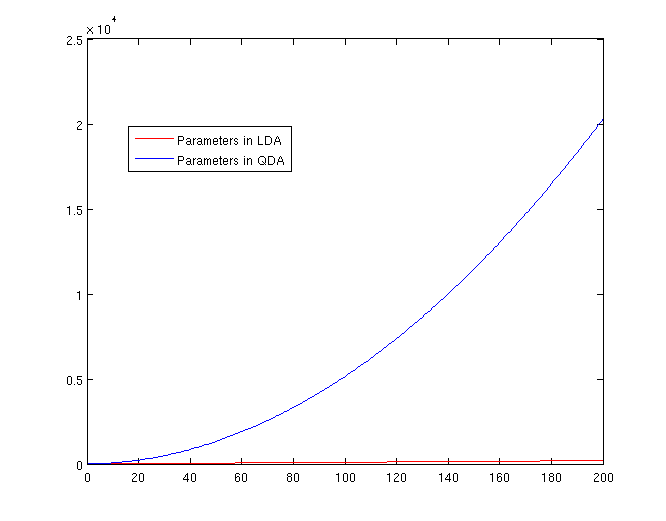
LDA and QDA in Matlab - October 7, 2009
We have examined the theory behind Linear Discriminant Analysis (LDA) and Quadratic Discriminant Analysis (QDA) above; how do we use these algorithms in practice? Matlab offers us a function called classify that allows us to perform LDA and QDA quickly and easily.
In class, we were shown an example of using LDA and QDA on the 2_3 data that is used in the first assignment. The code below reproduces that example, slightly modified, and explains each step.
>> load 2_3; >> [U, sample] = princomp(X'); >> sample = sample(:,1:2);
- First, we do principal component analysis (PCA) on the 2_3 data to reduce the dimensionality of the original data from 64 dimensions to 2. Doing this makes it much easier to visualize the results of the LDA and QDA algorithms.
>> plot (sample(1:200,1), sample(1:200,2), '.'); >> hold on; >> plot (sample(201:400,1), sample(201:400,2), 'r.');
- Recall that in the 2_3 data, the first 200 elements are images of the number two handwritten and the last 200 elements are images of the number three handwritten. This code sets up a plot of the data such that the points that represent a 2 are blue, while the points that represent a 3 are red.
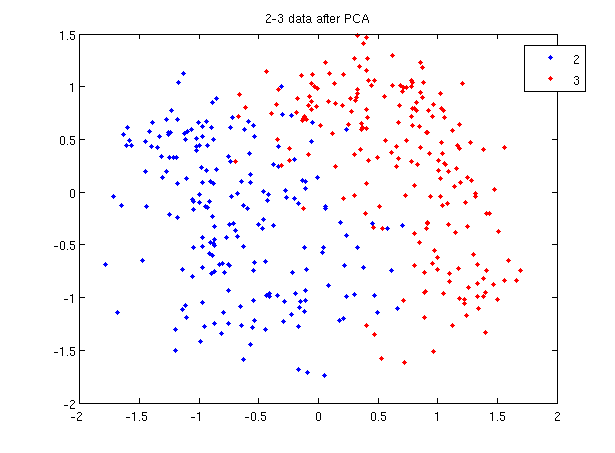
title and legend for information on adding the title and legend.- Before using
classifywe can set up a vector that contains the actual labels for our data, to train the classification algorithm. If we don't know the labels for the data, then the element in thegroupvector should be an empty string orNaN. (See grouping data for more information.)
>> group = ones(400,1); >> group(201:400) = 2;
- We can now classify our data.
>> [class, error, POSTERIOR, logp, coeff] = classify(sample, sample, group, 'linear');
- The full details of this line can be examined in the Matlab help file linked above. What we care about are
class, which contains the labels that the algorithm thinks that each data point belongs to, andcoeff, which contains information about the line that algorithm created to separate the data into each class.
- We can see the efficacy of the algorithm by comparing
classtogroup.
>> sum (class==group) ans = 369
- This compares the value in
classto the value ingroup. The answer of 369 tells us that the algorithm correctly determined the class of the point 369 times, out of a possible 400 data points. This gives us an empirical error rate of 0.0775.
- We can see the line produced by LDA using
coeff.
>> k = coeff(1,2).const;
>> l = coeff(1,2).linear;
>> f = sprintf('0 = %g+%g*x+%g*y', k, l(1), l(2));
>> ezplot(f, [min(sample(:,1)), max(sample(:,1)), min(sample(:,2)), max(sample(:,2))]);
- Those familiar with the programming language C will find the
sprintfline refreshingly familiar; those with no exposure to C are directed to Matlab'ssprintfpage. Essentially, this code sets up the equation of the line in the form0 = a + bx + cy. We then use theezplotfunction to plot the line.
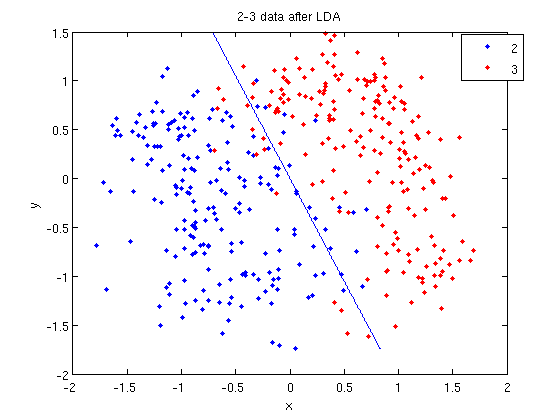
- Let's perform the same steps, except this time using QDA. The main difference with QDA is a slightly different call to
classify, and a more complicated procedure to plot the line.
>> [class, error, POSTERIOR, logp, coeff] = classify(sample, sample, group, 'quadratic');
>> sum (class==group)
ans =
371
>> k = coeff(1,2).const;
>> l = coeff(1,2).linear;
>> q = coeff(1,2).quadratic;
>> f = sprintf('0 = %g+%g*x+%g*y+%g*x^2+%g*x.*y+%g*y.^2', k, l, q(1,1), q(1,2)+q(2,1), q(2,2));
>> ezplot(f, [min(sample(:,1)), max(sample(:,1)), min(sample(:,2)), max(sample(:,2))]);
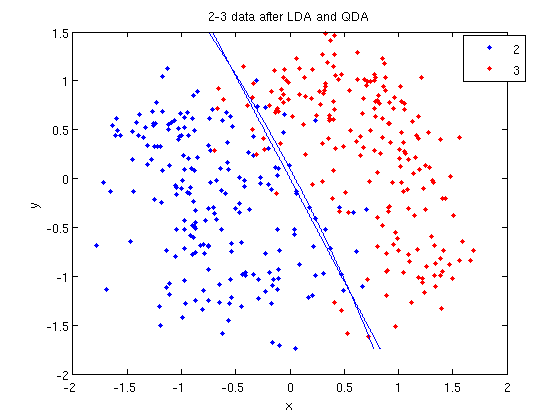
classify can also be used with other discriminant analysis algorithms. The steps laid out above would only need to be modified slightly for those algorithms.
Recall: An analysis of the function of princomp in matlab.
In our assignment 1, we have learnt that how to perform Principal Component Analysis using SVD method. In fact, the matlab offers us a function called princomp which can perform PCA conveniently. From the matlab help file on princomp, you can find the details about this function. But here we will analyze the code of the function of princomp() in matlab to find something different when comparing with SVD method. The following is the code of princomp and explanations to some emphasized steps.
function [pc, score, latent, tsquare] = princomp(x);
% PRINCOMP Principal Component Analysis (centered and scaled data).
% [PC, SCORE, LATENT, TSQUARE] = PRINCOMP(X) takes a data matrix X and
% returns the principal components in PC, the so-called Z-scores in SC
% ORES, the eigenvalues of the covariance matrix of X in LATENT,
% and Hotelling's T-squared statistic for each data point in TSQUARE.
% Reference: J. Edward Jackson, A User's Guide to Principal Components
% John Wiley & Sons, Inc. 1991 pp. 1-25.
% B. Jones 3-17-94
% Copyright 1993-2002 The MathWorks, Inc.
% $Revision: 2.9 $ $Date: 2002/01/17 21:31:45 $
[m,n] = size(x); % get the lengh of the rows and columns of matrix x.
r = min(m-1,n); % max possible rank of X
avg = mean(x); % the mean of every column of X
centerx = (x - avg(ones(m,1),:));
% centers X by subtracting off column means
[U,latent,pc] = svd(centerx./sqrt(m-1),0);
% "economy size" decomposition
score = centerx*pc;
% the representation of X in the principal component space
if nargout < 3
return;
end
latent = diag(latent).^2;
if (r latent = [latent(1:r); zeros(n-r,1)];
score(:,r+1:end) = 0;
end
if nargout < 4
return;
end
tmp = sqrt(diag(1./latent(1:r)))*score(:,1:r)';
tsquare = sum(tmp.*tmp)';
From the above code, we should pay attention to the following aspects when comparing with SVD method:
First, Rows of [math]\displaystyle{ \,X }[/math] correspond to observations, columns to variables. When using princomp on 2_3 data in assignment 1, note that we take the transpose of [math]\displaystyle{ \,X }[/math].
>> load 2_3; >> [U, score] = princomp(X');
Second, princomp centers X by subtracting off column means.
The third, when [math]\displaystyle{ \,X=UdV' }[/math], princomp uses [math]\displaystyle{ \,V }[/math] as coefficients for principal components, rather than [math]\displaystyle{ \,U }[/math].
The following is an example to perform PCA using princomp and SVD respectively to get the same results.
- SVD method
>> load 2_3 >> mn=mean(X,2); >> X1=X-repmat(mn,1,400); >> [s d v]=svd(X1'); >> y=X1'*v;
- princomp
>>[U score]=princomp(X');
Then we can see that y=score, v=U.
Trick: Using LDA to do QDA - October 7, 2009
There is a trick that allows us to use the linear discriminant analysis (LDA) algorithm to generate as its output a quadratic function that can be used to classify data. This trick is similar to, but more primitive than, the Kernel trick that will be discussed later in the course.
Essentially, the trick involves adding one or more new features (i.e. new dimensions) that just contain our original data projected to that dimension. We then do LDA on our new higher-dimensional data. The answer provided by LDA can then be collapsed onto a lower dimension, giving us a quadratic answer.
Motivation
Why would we want to use LDA over QDA? In situations where we have fewer data points, LDA turns out to be more robust.
If we look back at the equations for LDA and QDA, we see that in LDA we must estimate [math]\displaystyle{ \,\mu_1 }[/math], [math]\displaystyle{ \,\mu_2 }[/math] and [math]\displaystyle{ \,\Sigma }[/math]. In QDA we must estimate all of those, plus another [math]\displaystyle{ \,\Sigma }[/math]; the extra [math]\displaystyle{ \,\frac{d(d-1)}{2} }[/math] estimations make QDA less robust with fewer data points.
Theoretically
Suppose we can estimate some vector [math]\displaystyle{ \underline{w}^T }[/math] such that
[math]\displaystyle{ y = \underline{w}^Tx }[/math]
where [math]\displaystyle{ \underline{w} }[/math] is a d-dimensional column vector, and [math]\displaystyle{ x\ \epsilon\ \Re^d }[/math] (vector in d dimensions).
We also have a non-linear function [math]\displaystyle{ g(x) = y = x^Tvx + \underline{w}^Tx }[/math] that we cannot estimate.
Using our trick, we create two new vectors, [math]\displaystyle{ \,\underline{w}^* }[/math] and [math]\displaystyle{ \,x^* }[/math] such that:
[math]\displaystyle{ \underline{w}^{*T} = [w_1,w_2,...,w_d,v_1,v_2,...,v_d] }[/math]
and
[math]\displaystyle{ x^{*T} = [x_1,x_2,...,x_d,{x_1}^2,{x_2}^2,...,{x_d}^2] }[/math]
We can then estimate a new function, [math]\displaystyle{ g^*(x,x^2) = y^* = \underline{w}^{*T}x^* }[/math].
Note that we can do this for any [math]\displaystyle{ x }[/math] and in any dimension; we could extend a [math]\displaystyle{ D \times n }[/math] matrix to a quadratic dimension by appending another [math]\displaystyle{ D \times n }[/math] matrix with the original matrix squared, to a cubic dimension with the original matrix cubed, or even with a different function altogether, such as a [math]\displaystyle{ \,sin(x) }[/math] dimension.
By Example
Let's use our trick to do a quadratic analysis of the 2_3 data using LDA.
>> load 2_3; >> [U, sample] = princomp(X'); >> sample = sample(:,1:2);
- We start off the same way, by using PCA to reduce the dimensionality of our data to 2.
>> X_star = zeros(400,4);
>> X_star(:,1:2) = sample(:,:);
>> for i=1:400
for j=1:2
X_star(i,j+2) = X_star(i,j)^2;
end
end
- This projects our sample into two more dimensions by squaring our initial two dimensional data set.
>> group = ones(400,1); >> group(201:400) = 2; >> [class, error, POSTERIOR, logp, coeff] = classify(X_star, X_star, group, 'linear'); >> sum (class==group) ans = 375
- We can now display our results.
>> k = coeff(1,2).const;
>> l = coeff(1,2).linear;
>> f = sprintf('0 = %g+%g*x+%g*y+%g*(x)^2+%g*(y)^2', k, l(1), l(2),l(3),l(4));
>> ezplot(f,[min(sample(:,1)), max(sample(:,1)), min(sample(:,2)), max(sample(:,2))]);
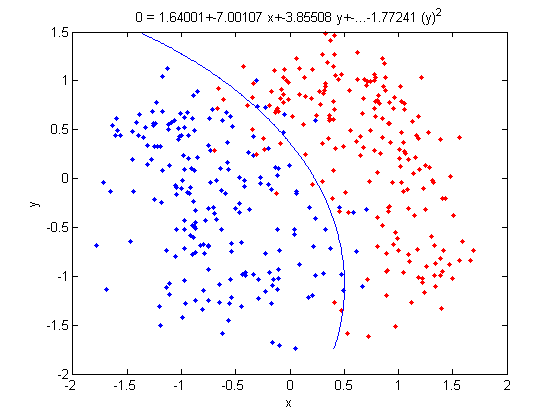
- Not only does LDA give us a better result than it did previously, it actually beats QDA, which only correctly classified 371 data points for this data set. Continuing this procedure by adding another two dimensions with [math]\displaystyle{ x^4 }[/math] (i.e. we set
X_star(i,j+2) = X_star(i,j)^4) we can correctly classify 376 points.
Introduction to Fisher's Discriminant Analysis - October 7, 2009
Fisher's Discriminant Analysis (FDA), also known as Fisher's Linear Discriminant Analysis (LDA) in some sources, is a classical feature extraction technique. It was originally described in 1936 by Sir Ronald Aylmer Fisher, an English statistician and eugenicist who has been described as one of the founders of modern statistical science. His original paper describing FDA can be found here; a Wikipedia article summarizing the algorithm can be found here.
LDA is for classification and FDA is used for feature extraction.
Contrasting FDA with PCA
The goal of FDA is in contrast to our other main feature extraction technique, principal component analysis (PCA).
- In PCA, we map data to lower dimensions to maximize the variation in those dimensions.
- In FDA, we map data to lower dimensions to best separate data in different classes.
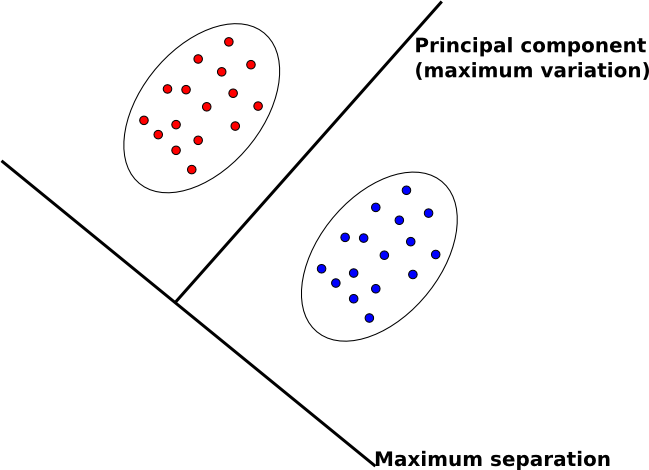
Because we are concerned with identifying which class data belongs to, FDA is often a better feature extraction algorithm for classification.
Another difference between PCA and FDA is that FDA is a supervised algorithm; that is, we know what class data belongs to, and we exploit that knowledge to find a good projection to lower dimensions.
Intuitive Description of FDA
An intuitive description of FDA can be given by visualizing two clouds of data, as shown above. Ideally, we would like to collapse all of the data points in each cloud onto one point on some projected line, then make those two points as far apart as possible. In doing so, we make it very easy to tell which class a data point belongs to. In practice, it is not possible to collapse all of the points in a cloud to one point, but we attempt to make all of the points in a cloud close to each other while simultaneously far from the points in the other cloud.
Example in R
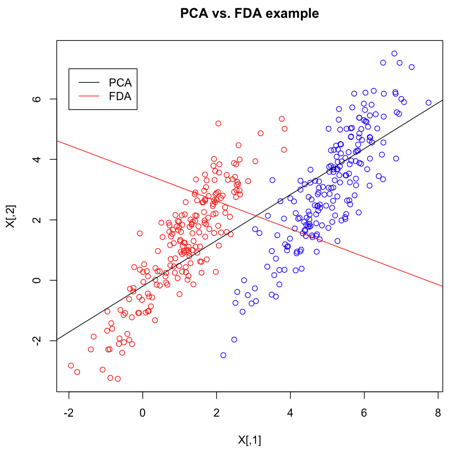
>> X = matrix(nrow=400,ncol=2)
>> X[1:200,] = mvrnorm(n=200,mu=c(1,1),Sigma=matrix(c(1,1.5,1.5,3),2))
>> X[201:400,] = mvrnorm(n=200,mu=c(5,3),Sigma=matrix(c(1,1.5,1.5,3),2))
>> Y = c(rep("red",200),rep("blue",200))
- Create 2 multivariate normal random variables with [math]\displaystyle{ \, \mu_1 = \left( \begin{array}{c}1 \\ 1 \end{array} \right), \mu_2 = \left( \begin{array}{c}5 \\ 3 \end{array} \right). ~\textrm{Cov} = \left( \begin{array}{cc} 1 & 1.5 \\ 1.5 & 3 \end{array} \right) }[/math]. Create
Y, an index indicating which class they belong to.
>> s <- svd(X,nu=1,nv=1)
- Calculate the singular value decomposition of X. The most significant direction is in
s$v[,1], and is displayed as a black line.
>> s2 <- lda(X,grouping=Y)
- The
ldafunction, given the group for each item, uses Fischer's Linear Discriminant Analysis (FLDA) to find the most discriminant direction. This can be found ins2$scaling.
Now that we've calculated the PCA and FLDA decompositions, we create a plot to demonstrate the differences between the two algorithms. FLDA is clearly better suited to discriminating between two classes whereas PCA is primarily good for reducing the number of dimensions when data is high-dimensional.
>> plot(X,col=Y,main="PCA vs. FDA example")
- Plot the set of points, according to colours given in Y.
>> slope = s$v[2]/s$v[1] >> intercept = mean(X[,2])-slope*mean(X[,1]) >> abline(a=intercept,b=slope)
- Plot the main PCA direction, drawn through the mean of the dataset. Only the direction is significant.
>> slope2 = s2$scaling[2]/s2$scaling[1] >> intercept2 = mean(X[,2])-slope2*mean(X[,1]) >> abline(a=intercept2,b=slope2,col="red")
- Plot the FLDA direction, again through the mean.
>> legend(-2,7,legend=c("PCA","FDA"),col=c("black","red"),lty=1)
- Labeling the lines directly on the graph makes it easier to interpret.
Ficher's Discriminant Analysis (FDA)
The goal of FDA is to reduce the dimensionality of data in order to have separable data points in a new space. We can consider two kinds of problems:
- 2-class problem
- multi-class problem
Two-class problem - October 9, 2009
In the two-class problem, we have the pre-knowledge that data points belong to two classes. Intuitively speaking points of each class form a cloud around the mean of the class, with each class having possibly different size. To be able to separate the two classes we must determine the class whose mean is closest to a given point while also accounting for the different size of each class, which is represented by the covariance of each class.
Assume [math]\displaystyle{ \underline{\mu_{1}}=\frac{1}{n_{1}}\displaystyle\sum_{i:y_{i}=1}\underline{x_{i}} }[/math] and [math]\displaystyle{ \displaystyle\Sigma_{1} }[/math], represent the mean and covariance of the 1st class, and [math]\displaystyle{ \underline{\mu_{2}}=\frac{1}{n_{2}}\displaystyle\sum_{i:y_{i}=2}\underline{x_{i}} }[/math] and [math]\displaystyle{ \displaystyle\Sigma_{2} }[/math] represent the mean and covariance of the 2nd class. We have to find a transformation which satisfies the following goals:
1.To make the means of these two classes as far apart as possible
- In other words, the goal is to maximize the distance after projection between class 1 and class 2. This can be done by maximizing the distance between the means of the classes after projection. When projecting the data points to a one-dimensional space, all points will be projected to a single line; the line we seek is the one with the direction that achieves maximum separation of classes upon projetion. If the original points are [math]\displaystyle{ \underline{x_{i}} \in \mathbb{R}^{d} }[/math]and the projected points are [math]\displaystyle{ \underline{w}^T \underline{x_{i}} }[/math] then the mean of the projected points will be [math]\displaystyle{ \underline{w}^T \underline{\mu_{1}} }[/math] and [math]\displaystyle{ \underline{w}^T \underline{\mu_{2}} }[/math] for class 1 and class 2 respectively. The goal now becomes to maximize the Euclidean distance between projected means, [math]\displaystyle{ (\underline{w}^T\underline{\mu_{1}}-\underline{w}^T\underline{\mu_{2}})^T (\underline{w}^T\underline{\mu_{1}}-\underline{w}^T\underline{\mu_{2}}) }[/math]. The steps of this maximization are given below.
2.We want to collapse all data points of each class to a single point, i.e., minimize the covariance within classes
- Notice that the variance of the projected classes 1 and 2 are given by [math]\displaystyle{ \underline{w}^T\Sigma_{1}\underline{w} }[/math] and [math]\displaystyle{ \underline{w}^T\Sigma_{2}\underline{w} }[/math]. The second goal is to minimize the sum of these two covariances.
As is demonstrated below, both of these goals can be accomplished simultaneously.
Original points are [math]\displaystyle{ \underline{x_{i}} \in \mathbb{R}^{d} }[/math]
Projected points are [math]\displaystyle{ \underline{z_{i}} \in \mathbb{R}^{1} }[/math] with [math]\displaystyle{ \underline{z_{i}} = \underline{w}^T \cdot\underline{x_{i}} }[/math]
Between class covariance
In this particular case, we want to project all the data points in one dimensional space.
We want to maximize the Euclidean distance between projected means, which is
- [math]\displaystyle{ \begin{align} (\underline{w}^T \underline{\mu_{1}} - \underline{w}^T \underline{\mu_{2}})^T(\underline{w}^T \underline{\mu_{1}} - \underline{w}^T \underline{\mu_{2}}) &= (\underline{\mu_{1}}-\underline{\mu_{2}})^T\underline{w} . \underline{w}^T(\underline{\mu_{1}}-\underline{\mu_{2}})\\ &= \underline{w}^T(\underline{\mu_{1}}-\underline{\mu_{2}})(\underline{\mu_{1}}-\underline{\mu_{2}})^T\underline{w} \end{align} }[/math]
The quantity [math]\displaystyle{ (\underline{\mu_{1}}-\underline{\mu_{2}})(\underline{\mu_{1}}-\underline{\mu_{2}})^T }[/math] is called between class covariance or [math]\displaystyle{ \,S_{B} }[/math].
The goal is to maximize : [math]\displaystyle{ \underline{w}^T S_{B} \underline{w} }[/math]
Within class covariance
Covariance of class 1 is [math]\displaystyle{ \,\Sigma_{1} }[/math] Covariance of class 2 is [math]\displaystyle{ \,\Sigma_{2} }[/math] So covariance of projected points will be [math]\displaystyle{ \,\underline{w}^T \Sigma_{1} \underline{w} }[/math] and [math]\displaystyle{ \underline{w}^T \Sigma_{2} \underline{w} }[/math]
If we sum this two quantities we have
- [math]\displaystyle{ \begin{align} \underline{w}^T \Sigma_{1} \underline{w} + \underline{w}^T \Sigma_{2} \underline{w} &= \underline{w}^T(\Sigma_{1} + \Sigma_{2})\underline{w} \end{align} }[/math]
The quantity [math]\displaystyle{ \,(\Sigma_{1} + \Sigma_{2}) }[/math] is called within class covariance or [math]\displaystyle{ \,S_{W} }[/math]
The goal is to minimize [math]\displaystyle{ \underline{w}^T S_{W} \underline{w} }[/math]
Objective Function
Instead of maximizing [math]\displaystyle{ \underline{w}^T S_{B} \underline{w} }[/math] and minimizing [math]\displaystyle{ \underline{w}^T S_{W} \underline{w} }[/math] we can define the following objective function:
- [math]\displaystyle{ \underset{\underline{w}}{max}\ \frac{\underline{w}^T S_{B} \underline{w}}{\underline{w}^T S_{W} \underline{w}} }[/math]
This maximization problem is equivalent to [math]\displaystyle{ \underset{\underline{w}}{max}\ \underline{w}^T S_{B} \underline{w} }[/math] subject to constraint [math]\displaystyle{ \underline{w}^T S_{W} \underline{w} = 1 }[/math]. We can use the Lagrange multiplier method to solve it:
- [math]\displaystyle{ L(\underline{w},\lambda) = \underline{w}^T S_{B} \underline{w} - \lambda(\underline{w}^T S_{W} \underline{w} - 1) }[/math]
With [math]\displaystyle{ \frac{\part L}{\part \underline{w}} = 0 }[/math] we get:
- [math]\displaystyle{ \begin{align} &\Rightarrow\ 2\ S_{B}\ \underline{w}\ - 2\lambda\ S_{W}\ \underline{w}\ = 0\\ &\Rightarrow\ S_{B}\ \underline{w}\ =\ \lambda\ S_{W}\ \underline{w} \\ &\Rightarrow\ S_{W}^{-1}\ S_{B}\ \underline{w}\ =\ \lambda\ \underline{w} \end{align} }[/math]
Note that [math]\displaystyle{ \, S_{W}=\Sigma_1+\Sigma_2 }[/math] is sum of two positive matrices and so it has an inverse.
Here [math]\displaystyle{ \underline{w} }[/math] is the eigenvector of [math]\displaystyle{ S_{w}^{-1}\ S_{B} }[/math] corresponding to the largest eigenvalue.
In facts, this expression can be simplified even more.
- [math]\displaystyle{ \Rightarrow\ S_{w}^{-1}\ S_{B}\ \underline{w}\ =\ \lambda\ \underline{w} }[/math] with [math]\displaystyle{ S_{B}\ =\ (\underline{\mu_{1}}-\underline{\mu_{2}})(\underline{\mu_{1}}-\underline{\mu_{2}})^T }[/math]
- [math]\displaystyle{ \Rightarrow\ S_{w}^{-1}\ (\underline{\mu_{1}}-\underline{\mu_{2}})(\underline{\mu_{1}}-\underline{\mu_{2}})^T \underline{w}\ =\ \lambda\ \underline{w} }[/math]
The quantity [math]\displaystyle{ (\underline{\mu_{1}}-\underline{\mu_{2}})^T \underline{w} }[/math] and [math]\displaystyle{ \lambda }[/math] are scalars.
So we can say the quantity [math]\displaystyle{ S_{w}^{-1}\ (\underline{\mu_{1}}-\underline{\mu_{2}}) }[/math] is proportional to [math]\displaystyle{ \underline{w} }[/math]
FDA vs. PCA Example in Matlab
We can compare PCA and FDA through the figure produced by matlab.
The following are the code to produce the figure step by step and the explanation for steps.
>>X1=mvnrnd([1,1],[1 1.5;1.5 3],300); >>X2=mvnrnd([5,3],[1 1.5;1.5 3],300); >>X=[X1;X2];
- Create two multivariate normal random variables with [math]\displaystyle{ \, \mu_1 = \left( \begin{array}{c}1 \\ 1 \end{array} \right), \mu_2 = \left( \begin{array}{c}5 \\ 3 \end{array} \right). ~\textrm{Cov} = \left( \begin{array}{cc} 1 & 1.5 \\ 1.5 & 3 \end{array} \right) }[/math].
>>plot(X(1:300,1),X(1:300,2),'.'); >>hold on >>p1=plot(X(301:600,1),X(301:600,2),'r.');
- Plot the the data of the two classes respectively.
>>[U Y]=princomp(X); >>plot([0 U(1,1)*10],[0 U(2,1)*10]);
- Using PCA to find the principal component and plot it.
>>sw=2*[1 1.5;1.5 3]; >>sb=([1; 1]-[5 ;3])*([1; 1]-[5; 3])'; >>g =inv(sw)*sb; >>[v w]=eigs(g); >>plot([v(1,1)*5 0],[v(2,1)*5 0],'r')
- Using FDA to find the principal component and plot it.
Now we can compare them through the figure.
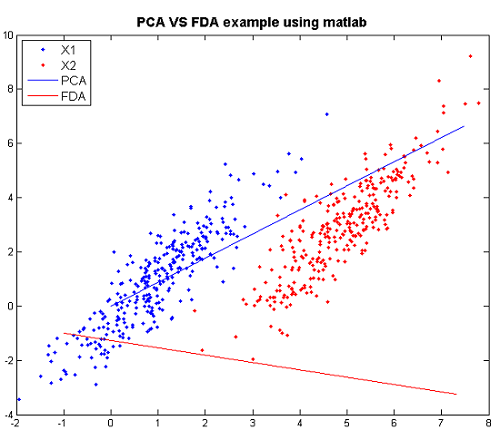
Practical example of 2_3
In this matlab example we explore FDA using our familiar data set 2_3 which consists of 200 handwritten "2" and 200 handwritten "3".
X is a matrix of size 64*400 and each column represents an 8*8 image of "2" or "3". Here X1 gets all "2" and X2 gets all "3".
>>load 2_3 >>X1 = X(:, 1:200); >>X2 = X(:, 201:400);
Next we calculate within class covariance and between class covariance as before.
>>mu1 = mean(X1, 2); >>mu2 = mean(X2, 2); >>sb = (mu1 - mu2) * (mu1 - mu2)'; >>sw = cov(X1') + cov(X2');
We use the first two eigenvectors to project the dato in a two-dimensional space.
>>[v d] = eigs( inv(sw) * sb ); >>w = v(:, 1:2); >>X_hat = w'*X;
Finally we plot the data and visualize the effect of FDA.
>> scatter(ones(1,200),X_hat(1:200)) >> hold on >> scatter(ones(1,200),X_hat(201:400),'r')
FDA for Multi-class Problems - October 14, 2009
For the [math]\displaystyle{ k }[/math]-class problem, we need to find a projection from [math]\displaystyle{ d }[/math]-dimensional space to a [math]\displaystyle{ (k-1) }[/math]-dimensional space.
(It is more reasonable to have at least 2 directions)
Basically, the within class covariance matrix [math]\displaystyle{ \mathbf{S}_{W} }[/math] is easily to obtain:
- [math]\displaystyle{ \begin{align} \mathbf{S}_{W} = \sum_{i=1}^{k} \mathbf{S}_{W,i} \end{align} }[/math]
where [math]\displaystyle{ \mathbf{S}_{W,i} = \frac{1}{n_{i}}\sum_{j: y_{j}=i}(\mathbf{x}_{j} - \mathbf{\mu}_{i})(\mathbf{x}_{j} - \mathbf{\mu}_{i})^{T} }[/math] and [math]\displaystyle{ \mathbf{\mu}_{i} = \frac{\sum_{j: y_{j}=i}\mathbf{x}_{j}}{n_{i}} }[/math].
However, the between class covariance matrix [math]\displaystyle{ \mathbf{S}_{B} }[/math] is not easy to obtain. One of the simplifications is that we may assume that the total covariance [math]\displaystyle{ \mathbf{S}_{T} }[/math] of the data is constant, since [math]\displaystyle{ \mathbf{S}_{W} }[/math] is easy to compute, we can get [math]\displaystyle{ \mathbf{S}_{B} }[/math] using the following relationship:
- [math]\displaystyle{ \begin{align} \mathbf{S}_{B} = \mathbf{S}_{T} - \mathbf{S}_{W} \end{align} }[/math]
Actually, there is another generation for [math]\displaystyle{ \mathbf{S}_{B} }[/math]. Denote a total mean vector [math]\displaystyle{ \mathbf{\mu} }[/math] by
- [math]\displaystyle{ \begin{align} \mathbf{\mu} = \frac{1}{n}\sum_{i}\mathbf{x_{i}} = \frac{1}{n}\sum_{j=1}^{k}n_{j}\mathbf{\mu}_{j} \end{align} }[/math]
Thus the total covariance matrix [math]\displaystyle{ \mathbf{S}_{T} }[/math] is
- [math]\displaystyle{ \begin{align} \mathbf{S}_{T} = \sum_{i}(\mathbf{x_{i}-\mu})(\mathbf{x_{i}-\mu})^{T} \end{align} }[/math]
Thus we obtain
- [math]\displaystyle{ \begin{align} & \mathbf{S}_{T} = \sum_{i=1}^{k}\sum_{j: y_{j}=i}(\mathbf{x}_{j} - \mathbf{\mu}_{i} + \mathbf{\mu}_{i} - \mathbf{\mu})(\mathbf{x}_{j} - \mathbf{\mu}_{i} + \mathbf{\mu}_{i} - \mathbf{\mu})^{T} \\& = \sum_{i=1}^{k}\sum_{j: y_{j}=i}(\mathbf{x}_{j}-\mathbf{\mu}_{i})(\mathbf{x}_{j}-\mathbf{\mu}_{i})^{T}+ \sum_{i=1}^{k}\sum_{j: y_{j}=i}(\mathbf{\mu}_{i}-\mathbf{\mu})(\mathbf{\mu}_{i}-\mathbf{\mu})^{T} \\& = \mathbf{S}_{W} + \sum_{i=1}^{k} n_{i}(\mathbf{\mu}_{i}-\mathbf{\mu})(\mathbf{\mu}_{i}-\mathbf{\mu})^{T} \end{align} }[/math]
Since the total covariance [math]\displaystyle{ \mathbf{S}_{T} }[/math] is the sum of the within class covariance [math]\displaystyle{ \mathbf{S}_{W} }[/math] and the between class covariance [math]\displaystyle{ \mathbf{S}_{B} }[/math], we can denote the second term as the general between class covariance matrix [math]\displaystyle{ \mathbf{S}_{B} }[/math], thus we obtain
- [math]\displaystyle{ \begin{align} \mathbf{S}_{B} = \sum_{i=1}^{k} n_{i}(\mathbf{\mu}_{i}-\mathbf{\mu})(\mathbf{\mu}_{i}-\mathbf{\mu})^{T} \end{align} }[/math]
Therefore,
- [math]\displaystyle{ \begin{align} \mathbf{S}_{T} = \mathbf{S}_{W} + \mathbf{S}_{B} \end{align} }[/math]
Recall that in the two class case problem, we have
- [math]\displaystyle{ \begin{align} & \mathbf{S}_{B^{\ast}} = (\mathbf{\mu}_{1}-\mathbf{\mu}_{2})(\mathbf{\mu}_{1}-\mathbf{\mu}_{2})^{T} \\ & = (\mathbf{\mu}_{1}-\mathbf{\mu}+\mathbf{\mu}-\mathbf{\mu}_{2})(\mathbf{\mu}_{1}-\mathbf{\mu}+\mathbf{\mu}-\mathbf{\mu}_{2})^{T} \\ & = ((\mathbf{\mu}_{1}-\mathbf{\mu})-(\mathbf{\mu}_{2}-\mathbf{\mu}))((\mathbf{\mu}_{1}-\mathbf{\mu})-(\mathbf{\mu}_{2}-\mathbf{\mu}))^{T} \\ & = (\mathbf{\mu}_{1}-\mathbf{\mu})(\mathbf{\mu}_{1}-\mathbf{\mu})^{T}+(\mathbf{\mu}_{2}-\mathbf{\mu})(\mathbf{\mu}_{2}-\mathbf{\mu})^{T} \end{align} }[/math]
From the general form,
- [math]\displaystyle{ \begin{align} & \mathbf{S}_{B} = n_{1}(\mathbf{\mu}_{1}-\mathbf{\mu})(\mathbf{\mu}_{1}-\mathbf{\mu})^{T} + n_{2}(\mathbf{\mu}_{2}-\mathbf{\mu})(\mathbf{\mu}_{2}-\mathbf{\mu})^{T} \end{align} }[/math]
Apparently, they are very similar.
Now, we are trying to find the optimal transformation. Basically, we have
- [math]\displaystyle{ \begin{align} \mathbf{z}_{i} = \mathbf{W}^{T}\mathbf{x}_{i}, i=1,2,...,k-1 \end{align} }[/math]
where [math]\displaystyle{ \mathbf{z}_{i} }[/math] is a [math]\displaystyle{ (k-1)\times 1 }[/math] vector, [math]\displaystyle{ \mathbf{W} }[/math] is a [math]\displaystyle{ d\times (k-1) }[/math] transformation matrix, i.e. [math]\displaystyle{ \mathbf{W} = [\mathbf{w}_{1}, \mathbf{w}_{2},..., \mathbf{w}_{k-1}] }[/math], and [math]\displaystyle{ \mathbf{x}_{i} }[/math] is a [math]\displaystyle{ d\times 1 }[/math] column vector.
Thus we obtain
- [math]\displaystyle{ \begin{align} & \mathbf{S}_{W}^{\ast} = \sum_{i=1}^{k}\sum_{j: y_{j}=i}(\mathbf{W}^{T}\mathbf{x}_{j}-\mathbf{W}^{T}\mathbf{\mu}_{i})(\mathbf{W}^{T}\mathbf{x}_{j}-\mathbf{W}^{T}\mathbf{\mu}_{i})^{T} \\ & = \sum_{i=1}^{k}\sum_{j: y_{j}=i}\mathbf{W}^{T}(\mathbf{x}_{j}-\mathbf{\mu}_{i})(\mathbf{x}_{j}-\mathbf{\mu}_{i})\mathbf{W} \\ & = \mathbf{W}^{T}\left[\sum_{i=1}^{k}\sum_{j: y_{j}=i}(\mathbf{x}_{j}-\mathbf{\mu}_{i})(\mathbf{x}_{j}-\mathbf{\mu}_{i})\right]\mathbf{W} \\ & = \mathbf{W}^{T}\mathbf{S}_{W}\mathbf{W} \end{align} }[/math]
Similarly, we obtain
- [math]\displaystyle{ \begin{align} & \mathbf{S}_{B}^{\ast} = \sum_{i=1}^{k}n_{i}(\mathbf{W}^{T}\mathbf{\mu}_{i}-\mathbf{W}^{T}\mathbf{\mu})(\mathbf{W}^{T}\mathbf{\mu}_{i}-\mathbf{W}^{T}\mathbf{\mu})^{T} \\ & = \sum_{i=1}^{k}n_{i}\mathbf{W}^{T}(\mathbf{\mu}_{i}-\mathbf{\mu})(\mathbf{\mu}_{i}-\mathbf{\mu})^{T}\mathbf{W} \\ & = \mathbf{W}^{T}\left[ \sum_{i=1}^{k}n_{i}(\mathbf{\mu}_{i}-\mathbf{\mu})(\mathbf{\mu}_{i}-\mathbf{\mu})^{T}\right]\mathbf{W} \\ & = \mathbf{W}^{T}\mathbf{S}_{B}\mathbf{W} \end{align} }[/math]
Now, we use the determinant of the matrix, i.e. the product of the eigenvalues of the matrix, as our measure.
- [math]\displaystyle{ \begin{align} \phi(\mathbf{W}) = \frac{|\mathbf{S}_{B}^{\ast}|}{|\mathbf{S}_{W}^{\ast}|} = \frac{\mathbf{W}^{T}\mathbf{S}_{B}\mathbf{W}}{\mathbf{W}^{T}\mathbf{S}_{W}\mathbf{W}} \end{align} }[/math]
The solution for this question is that the columns of the transformation matrix [math]\displaystyle{ \mathbf{W} }[/math] are exactly the eigenvectors that correspond to largest [math]\displaystyle{ k-1 }[/math] eigenvalues with respect to
- [math]\displaystyle{ \begin{align} \mathbf{S}_{W}^{-1}\mathbf{S}_{B}\mathbf{w}_{i} = \lambda_{i}\mathbf{w}_{i} \end{align} }[/math]
Also, note that we can use
- [math]\displaystyle{ \begin{align} \sum_{i=1}^{k}n_{i}\|(\mathbf{W}^{T}\mathbf{\mu}_{i}-\mathbf{W}^{T}\mathbf{\mu})^{T}\|^{2} \end{align} }[/math]
as our measure.
Recall that
- [math]\displaystyle{ \begin{align} \|\mathbf{X}\|^2 = Tr(\mathbf{X}^{T}\mathbf{X}) \end{align} }[/math]
Thus we obtain that
- [math]\displaystyle{ \begin{align} & \sum_{i=1}^{k}n_{i}\|(\mathbf{W}^{T}\mathbf{\mu}_{i}-\mathbf{W}^{T}\mathbf{\mu})^{T}\|^{2} \\ & = \sum_{i=1}^{k}n_{i}Tr[(\mathbf{W}^{T}\mathbf{\mu}_{i}-\mathbf{W}^{T}\mathbf{\mu})(\mathbf{W}^{T}\mathbf{\mu}_{i}-\mathbf{W}^{T}\mathbf{\mu})^{T}] \\ & = Tr[\sum_{i=1}^{k}n_{i}(\mathbf{W}^{T}\mathbf{\mu}_{i}-\mathbf{W}^{T}\mathbf{\mu})(\mathbf{W}^{T}\mathbf{\mu}_{i}-\mathbf{W}^{T}\mathbf{\mu})^{T}] \\ & = Tr[\sum_{i=1}^{k}n_{i}\mathbf{W}^{T}(\mathbf{\mu}_{i}-\mathbf{\mu})(\mathbf{\mu}_{i}-\mathbf{\mu})^{T}\mathbf{W}] \\ & = Tr[\mathbf{W}^{T}\sum_{i=1}^{k}n_{i}(\mathbf{\mu}_{i}-\mathbf{\mu})(\mathbf{\mu}_{i}-\mathbf{\mu})^{T}\mathbf{W}] \\ & = Tr[\mathbf{W}^{T}\mathbf{S}_{B}\mathbf{W}] \end{align} }[/math]
Similarly, we can get [math]\displaystyle{ Tr[\mathbf{W}^{T}\mathbf{S}_{W}\mathbf{W}] }[/math]. Thus we have following criterion function
- [math]\displaystyle{ \begin{align} \phi(\mathbf{W}) = \frac{Tr[\mathbf{W}^{T}\mathbf{S}_{B}\mathbf{W}]}{Tr[\mathbf{W}^{T}\mathbf{S}_{W}\mathbf{W}]} \end{align} }[/math]
Similar to the two class case problem, we have:
max [math]\displaystyle{ Tr[\mathbf{W}^{T}\mathbf{S}_{B}\mathbf{W}] }[/math] subject to [math]\displaystyle{ Tr[\mathbf{W}^{T}\mathbf{S}_{W}\mathbf{W}]=1 }[/math]
To solve this optimization problem a Lagrange multiplier [math]\displaystyle{ \Lambda }[/math], which actually is a [math]\displaystyle{ d \times d }[/math] diagonal matrix, is introduced:
- [math]\displaystyle{ \begin{align} L(\mathbf{W},\Lambda) = Tr[\mathbf{W}^{T}\mathbf{S}_{W}\mathbf{B}] - \Lambda\left\{ Tr[\mathbf{W}^{T}\mathbf{S}_{W}\mathbf{W}] - 1 \right\} \end{align} }[/math]
Differentiating with respect to [math]\displaystyle{ \mathbf{W} }[/math] we obtain:
- [math]\displaystyle{ \begin{align} \frac{\partial L}{\partial \mathbf{W}} = (\mathbf{S}_{B} + \mathbf{S}_{B}^{T})\mathbf{W} - \Lambda (\mathbf{S}_{W} + \mathbf{S}_{W}^{T})\mathbf{W} \end{align} }[/math]
Note that the [math]\displaystyle{ \mathbf{S}_{B} }[/math] and [math]\displaystyle{ \mathbf{S}_{W} }[/math] are both symmetric matrices, thus set the first derivative to zero, we obtain:
- [math]\displaystyle{ \begin{align} \mathbf{S}_{B}\mathbf{W} - \Lambda\mathbf{S}_{W}\mathbf{W}=0 \end{align} }[/math]
Thus,
- [math]\displaystyle{ \begin{align} \mathbf{S}_{B}\mathbf{W} = \Lambda\mathbf{S}_{W}\mathbf{W} \end{align} }[/math]
where
- [math]\displaystyle{ \mathbf{\Lambda} = \begin{pmatrix} \lambda_{1} & & 0\\ &\ddots&\\ 0 & &\lambda_{d} \end{pmatrix} }[/math]
and [math]\displaystyle{ \mathbf{W} = [\mathbf{w}_{1}, \mathbf{w}_{2},..., \mathbf{w}_{k-1}] }[/math].
As a matter of fact, [math]\displaystyle{ \mathbf{\Lambda} }[/math] must have [math]\displaystyle{ \mathbf{k-1} }[/math] nonzero eigenvalues, because [math]\displaystyle{ rank({S}_{W}^{-1}\mathbf{S}_{B})=k-1 }[/math].
Therefore, the solution for this question is as same as the previous case. The columns of the transformation matrix [math]\displaystyle{ \mathbf{W} }[/math] are exactly the eigenvectors that correspond to largest [math]\displaystyle{ k-1 }[/math] eigenvalues with respect to
- [math]\displaystyle{ \begin{align} \mathbf{S}_{W}^{-1}\mathbf{S}_{B}\mathbf{w}_{i} = \lambda_{i}\mathbf{w}_{i} \end{align} }[/math]
Linear Regression Models - October 14, 2009
Regression analysis is a general statistical technique for modelling and analyzing how a dependent variable changes according to changes in independent variables. In classification, we are interested in how a label, [math]\displaystyle{ \,y }[/math], changes according to changes in [math]\displaystyle{ \,X }[/math].
We will start by considering a very simple regression model, the linear regression model.
General information on linear regression can be found at the University of South Florida and this MIT lecture.
For the purpose of classification, the linear regression model assumes that the regression function [math]\displaystyle{ \,E(Y|X) }[/math] is linear in the inputs [math]\displaystyle{ \,\mathbf{x}_{1}, ..., \mathbf{x}_{p} }[/math].
The linear regression model has the general form:
- [math]\displaystyle{ \begin{align} f(x) = \beta^{T}\mathbf{x}_{i}+\beta_{0} \end{align} }[/math]
where [math]\displaystyle{ \,\beta }[/math] is a [math]\displaystyle{ 1 \times d }[/math] vector.
Given input data [math]\displaystyle{ \,\mathbf{x}_{1}, ..., \mathbf{x}_{p} }[/math] and [math]\displaystyle{ \,y_{1}, ..., y_{p} }[/math] our goal is to find [math]\displaystyle{ \,\beta }[/math] and [math]\displaystyle{ \,\beta_0 }[/math] such that the linear model fits the data while minimizing sum of squared errors using the Least Squares method.
Note that vectors [math]\displaystyle{ \mathbf{x}_{i} }[/math] could be numerical inputs, transformations of the original data, i.e. [math]\displaystyle{ \log \mathbf{x}_{i} }[/math] or [math]\displaystyle{ \sin \mathbf{x}_{i} }[/math], or basis expansions, i.e. [math]\displaystyle{ \mathbf{x}_{i}^{2} }[/math] or [math]\displaystyle{ \mathbf{x}_{i}\times \mathbf{x}_{j} }[/math].
Denote [math]\displaystyle{ \mathbf{X} }[/math] as a [math]\displaystyle{ n\times(d+1) }[/math] matrix with each row an input vector (with 1 in the first position), [math]\displaystyle{ \,\beta = (\beta_0, \beta_1,..., \beta_{d})^{T} }[/math] and [math]\displaystyle{ \mathbf{y} }[/math] as a [math]\displaystyle{ n \times 1 }[/math] vector of outputs. We then try to minimize the residual sum-of-squares
- [math]\displaystyle{ \begin{align} \mathrm{RSS}(\beta)=(\mathbf{y}-\mathbf{X}\beta)(\mathbf{y}-\mathbf{X}\beta)^{T} \end{align} }[/math]
This is a quadratic function in the [math]\displaystyle{ \,d+1 }[/math] parameters. Differentiating with respect to [math]\displaystyle{ \,\beta }[/math] we obtain
- [math]\displaystyle{ \begin{align} \frac{\partial \mathrm{RSS}}{\partial \beta} = -2\mathbf{X}^{T}(\mathbf{y}-\mathbf{X}\beta) \end{align} }[/math]
- [math]\displaystyle{ \begin{align} \frac{\partial^{2}\mathrm{RSS}}{\partial \beta \partial \beta^{T}}=2\mathbf{X}^{T}\mathbf{X} \end{align} }[/math]
Set the first derivative to zero
- [math]\displaystyle{ \begin{align} \mathbf{X}^{T}(\mathbf{y}-\mathbf{X}\beta)=0 \end{align} }[/math]
we obtain the solution
- [math]\displaystyle{ \begin{align} \hat \beta = (\mathbf{X}^{T}\mathbf{X})^{-1}\mathbf{X}^{T}\mathbf{y} \end{align} }[/math]
Thus the fitted values at the inputs are
- [math]\displaystyle{ \begin{align} \mathbf{\hat y} = \mathbf{X}\hat\beta = \mathbf{X} (\mathbf{X}^{T}\mathbf{X})^{-1}\mathbf{X}^{T}\mathbf{y} \end{align} }[/math]
where [math]\displaystyle{ \mathbf{H} = \mathbf{X} (\mathbf{X}^{T}\mathbf{X})^{-1}\mathbf{X}^{T} }[/math] is called the hat matrix.
- Note For classification purposes, this is not a correct model. Recall the following application of Bayes classifier:
[math]\displaystyle{ r(x)= P( Y=k | X=x )= \frac{f_{k}(x)\pi_{k}}{\Sigma_{k}f_{k}(x)\pi_{k}} }[/math]
It is clear that to make sense mathematically, [math]\displaystyle{ \displaystyle r(x) }[/math] must be a value between 0 and 1. If this is estimated with the
regression function [math]\displaystyle{ \displaystyle r(x)=E(Y|X=x) }[/math] and [math]\displaystyle{ \mathbf{\hat\beta} }[/math] is learned as above, then there is nothing that would restrict [math]\displaystyle{ \displaystyle r(x) }[/math] to taking values between 0 and 1.
A linear regression example in Matlab
We can see how linear regression works through the following example in Matlab. The following is the code and the explanation for each step.
Again, we use the data in 2_3.m.
>>load 2_3; >>[U, sample] = princomp(X'); >>sample = sample(:,1:2);
We carry out Principal Component Analysis (PCA) to reduce the dimensionality from 64 to 2.
>>y = zeros(400,1); >>y(201:400) = 1;
We let y represent the set of labels coded as 0 and 1.
>>x=[sample;ones(1,400)];
Construct x by adding a row of vector 1 to data.
>>b=inv(x*x')*x*y;
Calculate b, which represents [math]\displaystyle{ \beta }[/math] in the linear regression model.
>>x1=x';
>>for i=1:400
if x1(i,:)*b>0.5
plot(x1(i,1),x1(i,2),'.')
hold on
elseif x1(i,:)*b < 0.5
plot(x1(i,1),x1(i,2),'r.')
end
end
Plot the fitted y values.
Logistic Regression- October 16, 2009
logistic function
A logistic function or logistic curve is the most common sigmoid curve.
- [math]\displaystyle{ y = \frac{1}{1+e^{-x}} }[/math]
1. [math]\displaystyle{ \frac{dy}{dx} = y(1-y)=\frac{e^{x}}{(1+e^{x})^{2}} }[/math]
2. [math]\displaystyle{ y(0) = \frac{1}{2} }[/math]
3. [math]\displaystyle{ \int y dx = ln(1 + e^{x}) }[/math]
4. [math]\displaystyle{ y(x) = \frac{1}{2} + \frac{1}{4}x - \frac{1}{48}x^{3} + \frac{1}{48}x^{5} \cdots }[/math]
5. The logistic curve shows early exponential growth for negative t, which slows to linear growth of slope 1/4 near t = 0, then approaches y = 1 with an exponentially decaying gap.
Intuition behind Logistic Regression
Recall that, for classification purposes, the linear regression model presented in the above section is not correct because it does not force [math]\displaystyle{ \,r(x) }[/math] to be between 0 and 1 and sum to 1. Consider the following log odds model (for two classes):
- [math]\displaystyle{ \log\left(\frac{P(Y=1|X=x)}{P(Y=0|X=x)}\right)=\beta^Tx }[/math]
Calculating [math]\displaystyle{ \,P(Y=1|X=x) }[/math] leads us to the logistic regression model, which as opposed to the linear regression model, allows the modelling of the posterior probabilities of the classes through linear methods and at the same time ensures that they sum to one and are between 0 and 1. It is a type of Generalized Linear Model (GLM).
The Logistic Regression Model
The logistic regression model for the two class case is defined as
Class 1

- [math]\displaystyle{ P(Y=1 | X=x) =\frac{\exp(\underline{\beta}^T \underline{x})}{1+\exp(\underline{\beta}^T \underline{x})}=P(x;\underline{\beta}) }[/math]
Then we have that
Class 0

- [math]\displaystyle{ P(Y=0 | X=x) = 1-P(Y=1 | X=x)=1-\frac{\exp(\underline{\beta}^T \underline{x})}{1+\exp(\underline{\beta}^T \underline{x})}=\frac{1}{1+\exp(\underline{\beta}^T \underline{x})} }[/math]
Fitting a Logistic Regression
Logistic regression tries to fit a distribution. The fitting of logistic regression models is usually accomplished by maximum likelihood, using Pr(Y|X). The maximum likelihood of [math]\displaystyle{ \underline\beta }[/math] maximizes the probability of obtaining the data [math]\displaystyle{ \displaystyle{x_{1},...,x_{n}} }[/math] from the known distribution. Combining [math]\displaystyle{ \displaystyle P(Y=1 | X=x) }[/math] and [math]\displaystyle{ \displaystyle P(Y=0 | X=x) }[/math] as follows, we can consider the two classes at the same time:
- [math]\displaystyle{ p(\underline{x_{i}};\underline{\beta}) = \left(\frac{\exp(\underline{\beta}^T \underline{x_i})}{1+\exp(\underline{\beta}^T \underline{x_i})}\right)^{y_i} \left(\frac{1}{1+\exp(\underline{\beta}^T \underline{x_i})}\right)^{1-y_i} }[/math]
Assuming the data [math]\displaystyle{ \displaystyle {x_{1},...,x_{n}} }[/math] is drawn independently, the likelihood function is
- [math]\displaystyle{ \begin{align} \mathcal{L}(\theta)&=p({x_{1},...,x_{n}};\theta)\\ &=\displaystyle p(x_{1};\theta) p(x_{2};\theta)... p(x_{n};\theta) \quad \mbox{(by independence)}\\ &= \prod_{i=1}^n p(x_{i};\theta) \end{align} }[/math]
Since it is more convenient to work with the log-likelihood function, take the log of both sides, we get
- [math]\displaystyle{ \displaystyle l(\theta)=\displaystyle \sum_{i=1}^n \log p(x_{i};\theta) }[/math]
So,
- [math]\displaystyle{ \begin{align} l(\underline\beta)&=\displaystyle\sum_{i=1}^n y_{i}\log\left(\frac{\exp(\underline{\beta}^T \underline{x_i})}{1+\exp(\underline{\beta}^T \underline{x_i})}\right)+(1-y_{i})\log\left(\frac{1}{1+\exp(\underline{\beta}^T\underline{x_i})}\right)\\ &= \displaystyle\sum_{i=1}^n y_{i}(\underline{\beta}^T\underline{x_i}-\log(1+\exp(\underline{\beta}^T\underline{x_i}))+(1-y_{i})(-\log(1+\exp(\underline{\beta}^T\underline{x_i}))\\ &= \displaystyle\sum_{i=1}^n y_{i}\underline{\beta}^T\underline{x_i}-y_{i} \log(1+\exp(\underline{\beta}^T\underline{x_i}))- \log(1+\exp(\underline{\beta}^T\underline{x_i}))+y_{i} \log(1+\exp(\underline{\beta}^T\underline{x_i}))\\ &=\displaystyle\sum_{i=1}^n y_{i}\underline{\beta}^T\underline{x_i}- \log(1+\exp(\underline{\beta}^T\underline{x_i}))\\ \end{align} }[/math]
To maximize the log-likelihood, set its derivative to 0.
- [math]\displaystyle{ \begin{align} \frac{\partial l}{\partial \underline{\beta}} &= \sum_{i=1}^n \left[{y_i} \underline{x}_i- \frac{\exp(\underline{\beta}^T \underline{x_i})}{1+\exp(\underline{\beta}^T \underline{x}_i)}\underline{x}_i\right]\\ &=\sum_{i=1}^n \left[{y_i} \underline{x}_i - p(\underline{x}_i;\underline{\beta})\underline{x}_i\right] \end{align} }[/math]
To solve this equation, the Newton-Raphson algorithm is used which requires the second derivative in addition to the first derivative. This is demonstrated in the next section.
Logistic Regression(2) - October 19, 2009
Logistic Regression Model
Recall that in the last lecture, we learned the logistic regression model.
- [math]\displaystyle{ P(Y=1 | X=x)=P(\underline{x}_i;\underline{\beta})=\frac{exp(\underline{\beta}^T \underline{x})}{1+exp(\underline{\beta}^T \underline{x})} }[/math]
- [math]\displaystyle{ P(Y=0 | X=x)=1-P(\underline{x}_i;\underline{\beta})=\frac{1}{1+exp(\underline{\beta}^T \underline{x})} }[/math]
Find [math]\displaystyle{ \underline{\beta} }[/math]
Criteria: find a [math]\displaystyle{ \underline{\beta} }[/math] that maximizes the conditional likelihood of Y given X using the training data.
From above, we have the first derivative of the log-likelihood:
[math]\displaystyle{ \frac{\partial l}{\partial \underline{\beta}} = \sum_{i=1}^n \left[{y_i} \underline{x}_i- \frac{exp(\underline{\beta}^T \underline{x_i})}{1+exp(\underline{\beta}^T \underline{x}_i)}\underline{x}_i\right] }[/math] [math]\displaystyle{ =\sum_{i=1}^n \left[{y_i} \underline{x}_i - P(\underline{x}_i;\underline{\beta})\underline{x}_i\right] }[/math]
The Newton-Raphson algorithm requires the second-derivative or Hessian matrix.
[math]\displaystyle{ \frac{\partial^{2} l}{\partial \underline{\beta} \partial \underline{\beta}^T }= \sum_{i=1}^n - \underline{x_i} \frac{(exp(\underline{\beta}^T\underline{x}_i) \underline{x}_i^T)(1+exp(\underline{\beta}^T \underline{x}_i))-\underline{x}_i exp(\underline{\beta}^T\underline{x}_i)exp(\underline{\beta}^T\underline{x}_i)}{(1+exp(\underline{\beta}^T \underline{x}))^2} }[/math]
(note: [math]\displaystyle{ \frac{\partial\underline{\beta}^T\underline{x}_i}{\partial \underline{\beta}^T}=\underline{x}_i^T }[/math] you can check it here, it's a very useful website including a Matrix Reference Manual that you can find information about linear algebra and the properties of real and complex matrices.)
- [math]\displaystyle{ =\sum_{i=1}^n - \underline{x}_i \frac{(-\underline{x}_i exp(\underline{\beta}^T\underline{x}_i) \underline{x}_i^T)}{(1+exp(\underline{\beta}^T \underline{x}))(1+exp(\underline{\beta}^T \underline{x}))} }[/math] (by cancellation)
- [math]\displaystyle{ =\sum_{i=1}^n - \underline{x}_i \underline{x}_i^T P(\underline{x}_i;\underline{\beta}))[1-P(\underline{x}_i;\underline{\beta})]) }[/math](since [math]\displaystyle{ P(\underline{x}_i;\underline{\beta})=\frac{exp(\underline{\beta}^T \underline{x})}{1+exp(\underline{\beta}^T \underline{x})} }[/math] and [math]\displaystyle{ 1-P(\underline{x}_i;\underline{\beta})=\frac{1}{1+exp(\underline{\beta}^T \underline{x})} }[/math])
The same second derivative can be achieved if we reduce the occurrences of beta to 1 by the identity[math]\displaystyle{ \frac{a}{1+a}=1-\frac{1}{1+a} }[/math]
And solving [math]\displaystyle{ \frac{\partial}{\partial \underline{\beta}^T}\sum_{i=1}^n \left[{y_i} \underline{x}_i-\left[1-\frac{1}{1+exp(\underline{\beta}^T \underline{x}_i)}\right]\underline{x}_i\right] }[/math]
Starting with [math]\displaystyle{ \,\underline{\beta}^{old} }[/math], the Newton-Raphson update is
[math]\displaystyle{ \,\underline{\beta}^{new}\leftarrow \,\underline{\beta}^{old}- (\frac{\partial ^2 l}{\partial \underline{\beta}\partial \underline{\beta}^T})^{-1}(\frac{\partial l}{\partial \underline{\beta}}) }[/math] where the derivatives are evaluated at [math]\displaystyle{ \,\underline{\beta}^{old} }[/math]
The iteration will terminate when [math]\displaystyle{ \underline{\beta}^{new} }[/math] is very close to [math]\displaystyle{ \underline{\beta}^{old} }[/math].
The iteration can be described in matrix form.
- Let [math]\displaystyle{ \,\underline{Y} }[/math] be the column vector of [math]\displaystyle{ \,y_i }[/math]. ([math]\displaystyle{ n\times1 }[/math])
- Let [math]\displaystyle{ \,X }[/math] be the [math]\displaystyle{ {d}\times{n} }[/math] input matrix.
- Let [math]\displaystyle{ \,\underline{P} }[/math] be the [math]\displaystyle{ {n}\times{1} }[/math] vector with [math]\displaystyle{ i }[/math]th element [math]\displaystyle{ P(\underline{x}_i;\underline{\beta}^{old}) }[/math].
- Let [math]\displaystyle{ \,W }[/math] be an [math]\displaystyle{ {n}\times{n} }[/math] diagonal matrix with [math]\displaystyle{ i }[/math]th element [math]\displaystyle{ P(\underline{x}_i;\underline{\beta}^{old})[1-P(\underline{x}_i;\underline{\beta}^{old})] }[/math]
then
[math]\displaystyle{ \frac{\partial l}{\partial \underline{\beta}} = X(\underline{Y}-\underline{P}) }[/math]
[math]\displaystyle{ \frac{\partial ^2 l}{\partial \underline{\beta}\partial \underline{\beta}^T} = -XWX^T }[/math]
The Newton-Raphson step is
[math]\displaystyle{ \underline{\beta}^{new} \leftarrow \underline{\beta}^{old}+(XWX^T)^{-1}X(\underline{Y}-\underline{P}) }[/math]
This equation is sufficient for computation of the logistic regression model. However, we can simplify further to uncover an interesting feature of this equation.
[math]\displaystyle{ \begin{align} \underline{\beta}^{new} &= (XWX^T)^{-1}(XWX^T)\underline{\beta}^{old}+(XWX^T)^{-1}XWW^{-1}(\underline{Y}-\underline{P})\\ &=(XWX^T)^{-1}XW[X^T\underline{\beta}^{old}+W^{-1}(\underline{Y}-\underline{P})]\\ &=(XWX^T)^{-1}XWZ \end{align} }[/math]
where [math]\displaystyle{ Z=X^T\underline{\beta}^{old}+W^{-1}(\underline{Y}-\underline{P}) }[/math]
Recall that linear regression by least square finds the following minimum: [math]\displaystyle{ \min_{\underline{\beta}}(\underline{y}-\underline{\beta}^T X)^T(\underline{y}-\underline{\beta}^TX) }[/math]
we have [math]\displaystyle{ \underline\hat{\beta}=(XX^T)^{-1}X\underline{y} }[/math]
Similarly, we can say that [math]\displaystyle{ \underline{\beta}^{new} }[/math] is the solution of a weighted least square problem:
[math]\displaystyle{ \underline{\beta}^{new} \leftarrow \min_{\underline{\beta}}(Z-X\underline{\beta}^T)W(Z-X\underline{\beta}) }[/math]
WLS
Actually, the weighted least squares estimator minimizes the weighted sum of squared errors [math]\displaystyle{ S(\beta) = \sum_{i=1}^{n}w_{i}[y_{i}-\mathbf{x}_{i}^{T}\beta]^{2} }[/math] where [math]\displaystyle{ \displaystyle w_{i}\gt 0 }[/math]. Hence the WLS estimator is given by [math]\displaystyle{ \hat\beta^{WLS}=\left[\sum_{i=1}^{n}w_{i}\mathbf{x}_{i}\mathbf{x}_{i}^{T} \right]^{-1}\left[ \sum_{i=1}^{n}w_{i}\mathbf{x}_{i}y_{i}\right] }[/math]
A weighted linear regression of the iteratively computed response [math]\displaystyle{ \mathbf{z}=\mathbf{X}^{T}\beta^{old}+\mathbf{W}^{-1}(\mathbf{y}-\mathbf{p}) }[/math]
Therefore, we obtain
- [math]\displaystyle{ \begin{align} & \hat\beta^{WLS}=\left[\sum_{i=1}^{n}w_{i}\mathbf{x}_{i}\mathbf{x}_{i}^{T} \right]^{-1}\left[ \sum_{i=1}^{n}w_{i}\mathbf{x}_{i}z_{i}\right] \\& = \left[ \mathbf{XWX}^{T}\right]^{-1}\left[ \mathbf{XWz}\right] \\& = \left[ \mathbf{XWX}^{T}\right]^{-1}\mathbf{XW}(\mathbf{X}^{T}\beta^{old}+\mathbf{W}^{-1}(\mathbf{y}-\mathbf{p})) \\& = \beta^{old}+ \left[ \mathbf{XWX}^{T}\right]^{-1}\mathbf{X}(\mathbf{y}-\mathbf{p}) \end{align} }[/math]
note:Here we obtain [math]\displaystyle{ \underline{\beta} }[/math], which is a [math]\displaystyle{ d\times{1} }[/math] vector, because we construct the model like [math]\displaystyle{ \underline{\beta}^T\underline{x} }[/math]. If we construct the model like [math]\displaystyle{ \underline{\beta}_0+ \underline{\beta}^T\underline{x} }[/math], then similar to linear regression, [math]\displaystyle{ \underline{\beta} }[/math] will be a [math]\displaystyle{ (d+1)\times{1} }[/math] vector.
- Choosing [math]\displaystyle{ \displaystyle\beta=0 }[/math] seems to be a suitable starting value for the Newton-Raphson iteration procedure in this case. However, this does not guarantee convergence. The procedure will usually converge since the log-likelihood function is concave(or convex). In the case that it does not, we can just prove the local convergence of the method, which means the iteration would converge only if the initial point is closed enough to the exact solution. However, in practice, choosing an appropriate initial value is really trivial, namely, it is not often to find a initial too far from the exact solution to make the iteration invalid. <ref>C. T. Kelley, Iterative Methods for Linear and Nonlinear Equations, chapter 5 </ref> Besides, step-size halving will solve this problem. <ref>H. Trevor, R. Tibshirani, J. Friedman, The Elements of Statistical Learning (Springer
2009),121.</ref>
Pseudo Code
- [math]\displaystyle{ \underline{\beta} \leftarrow 0 }[/math]
- Set [math]\displaystyle{ \,\underline{Y} }[/math], the label associated with each observation [math]\displaystyle{ \,i=1...n }[/math].
- Compute [math]\displaystyle{ \,\underline{P} }[/math] according to the equation [math]\displaystyle{ P(\underline{x}_i;\underline{\beta})=\frac{exp(\underline{\beta}^T \underline{x})}{1+exp(\underline{\beta}^T \underline{x})} }[/math] for all [math]\displaystyle{ \,i=1...n }[/math].
- Compute the diagonal matrix [math]\displaystyle{ \,W }[/math] by setting [math]\displaystyle{ \,w_i,i }[/math] to [math]\displaystyle{ P(\underline{x}_i;\underline{\beta}))[1-P(\underline{x}_i;\underline{\beta})] }[/math] for all [math]\displaystyle{ \,i=1...n }[/math].
- [math]\displaystyle{ Z \leftarrow X^T\underline{\beta}+W^{-1}(\underline{Y}-\underline{P}) }[/math].
- [math]\displaystyle{ \underline{\beta} \leftarrow (XWX^T)^{-1}XWZ }[/math].
- If the new [math]\displaystyle{ \underline{\beta} }[/math] value is sufficiently close to the old value, stop; otherwise go back to step 3.
Comparison with Linear Regression
- Similarities
- They are both to attempt to estimate [math]\displaystyle{ \,P(Y=k|X=x) }[/math] (For logistic regression, we just mentioned about the case that [math]\displaystyle{ \,k=0 }[/math] or [math]\displaystyle{ \,k=1 }[/math] now).
- They are both have linear boundaris.
- note:For linear regression, we assume the model is linear. The boundary is [math]\displaystyle{ P(Y=k|X=x)=\underline{\beta}^T\underline{x}_i+\underline{\beta}_0=0.5 }[/math] (linear)
- For logistic regression, the boundary is [math]\displaystyle{ P(Y=k|X=x)=\frac{exp(\underline{\beta}^T \underline{x})}{1+exp(\underline{\beta}^T \underline{x})}=0.5 \Rightarrow exp(\underline{\beta}^T \underline{x})=1\Rightarrow \underline{\beta}^T \underline{x}=0 }[/math] (linear)
- Differences
- Linear regression: [math]\displaystyle{ \,P(Y=k|X=x) }[/math] is linear function of [math]\displaystyle{ \,x }[/math], [math]\displaystyle{ \,P(Y=k|X=x) }[/math] is not guaranteed to fall between 0 and 1 and to sum up to 1.
- Logistic regression: [math]\displaystyle{ \,P(Y=k|X=x) }[/math] is a nonlinear function of [math]\displaystyle{ \,x }[/math], and it is guaranteed to range from 0 to 1 and to sum up to 1.
Comparison with LDA
- The linear logistic model only consider the conditional distribution [math]\displaystyle{ \,P(Y=k|X=x) }[/math]. No assumption is made about [math]\displaystyle{ \,P(X=x) }[/math].
- The LDA model specifies the joint distribution of [math]\displaystyle{ \,X }[/math] and [math]\displaystyle{ \,Y }[/math].
- Logistic regression maximizes the conditional likelihood of [math]\displaystyle{ \,Y }[/math] given [math]\displaystyle{ \,X }[/math]: [math]\displaystyle{ \,P(Y=k|X=x) }[/math]
- LDA maximizes the joint likelihood of [math]\displaystyle{ \,Y }[/math] and [math]\displaystyle{ \,X }[/math]: [math]\displaystyle{ \,P(Y=k,X=x) }[/math].
- If [math]\displaystyle{ \,\underline{x} }[/math] is d-dimensional,the number of adjustable parameter in logistic regression is [math]\displaystyle{ \,d }[/math]. The number of parameters grows linearly w.r.t dimension.
- If [math]\displaystyle{ \,\underline{x} }[/math] is d-dimensional,the number of adjustable parameter in LDA is [math]\displaystyle{ \,(2d)+d(d+1)/2+2=(d^2+5d+4)/2 }[/math]. The number of parameters grows quardratically w.r.t dimension.
- As logistic regression relies on fewer assumptions, it seems to be more robust.
- In practice, Logistic regression and LDA often give the similar results.
By example
Now we compare LDA and Logistic regression by an example. Again, we use them on the 2_3 data.
>>load 2_3; >>[U, sample] = princomp(X'); >>sample = sample(:,1:2); >>plot (sample(1:200,1), sample(1:200,2), '.'); >>hold on; >>plot (sample(201:400,1), sample(201:400,2), 'r.');
- First, we do PCA on the data and plot the data points that represent 2 or 3 in different colors. See the previous example for more details.
>>group = ones(400,1); >>group(201:400) = 2;
- Group the data points.
>>[B,dev,stats] = mnrfit(sample,group); >>x=[ones(1,400); sample'];
- Now we use mnrfit to use logistic regression to classfy the data. This function can return B which is a [math]\displaystyle{ (d+1)\times{(k–1)} }[/math] matrix of estimates, where each column corresponds to the estimated intercept term and predictor coefficients. In this case, B is a [math]\displaystyle{ 3\times{1} }[/math] matrix.
>> B B =0.1861 -5.5917 -3.0547
- This is our [math]\displaystyle{ \underline{\beta} }[/math]. So the posterior probabilities are:
- [math]\displaystyle{ P(Y=1 | X=x)=\frac{exp(0.1861-5.5917X_1-3.0547X_2)}{1+exp(0.1861-5.5917X_1-3.0547X_2)} }[/math].
- [math]\displaystyle{ P(Y=2 | X=x)=\frac{1}{1+exp(0.1861-5.5917X_1-3.0547X_2)} }[/math]
- The classification rule is:
- [math]\displaystyle{ \hat Y = 1 }[/math], if [math]\displaystyle{ \,0.1861-5.5917X_1-3.0547X_2\gt =0 }[/math]
- [math]\displaystyle{ \hat Y = 2 }[/math], if [math]\displaystyle{ \,0.1861-5.5917X_1-3.0547X_2\lt 0 }[/math]
>>f = sprintf('0 = %g+%g*x+%g*y', B(1), B(2), B(3));
>>ezplot(f,[min(sample(:,1)), max(sample(:,1)), min(sample(:,2)), max(sample(:,2))])
- Plot the decision boundary by logistic regression.
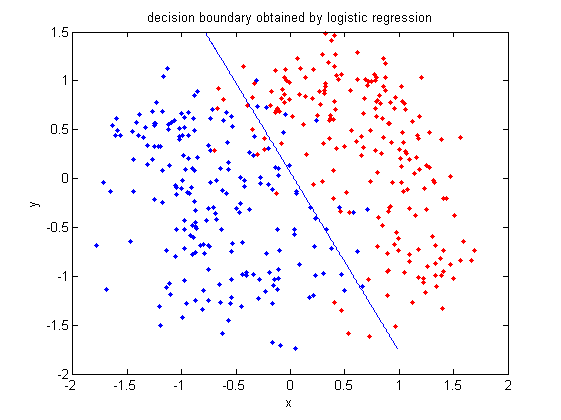
>>[class, error, POSTERIOR, logp, coeff] = classify(sample, sample, group, 'linear');
>>k = coeff(1,2).const;
>>l = coeff(1,2).linear;
>>f = sprintf('0 = %g+%g*x+%g*y', k, l(1), l(2));
>>h=ezplot(f, [min(sample(:,1)), max(sample(:,1)), min(sample(:,2)), max(sample(:,2))]);
- Plot the decision boundary by LDA. See the previous example for more information about LDA in matlab.
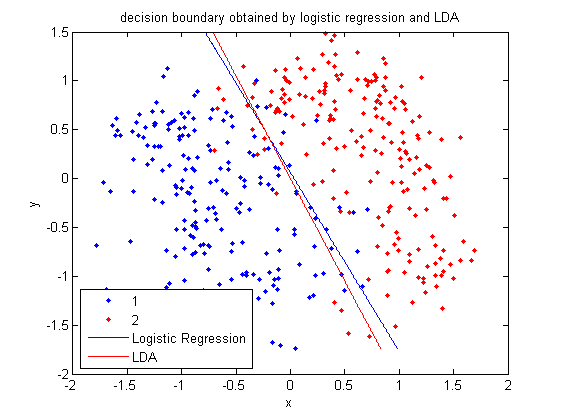
2009.10.21
Multi-Class Logistic Regression
Our earlier goal with logistic regression was to model the posteriors for a 2 class classification problem with a linear function bounded by the interval [0,1]. In that case our model was,
[math]\displaystyle{ \log\left(\frac{P(Y=1|X=x)}{P(Y=0|X=x)}\right)= \log\left(\frac{\frac{\exp(\beta^T x)}{1+\exp(\beta^T x)}}{\frac{1}{1+\exp(\beta^T x)}}\right) =\beta^Tx }[/math]
We can extend this idea to the more general case with K-classes. This model is specified with K - 1 terms where the Kth class in the denominator can be chosen arbitrarily.
[math]\displaystyle{ \log\left(\frac{P(Y=i|X=x)}{P(Y=K|X=x)}\right)=\beta_i^Tx,\quad i \in \{1,\dots,K-1\} }[/math]
The posteriors for each class are given by,
[math]\displaystyle{ P(Y=i|X=x) = \frac{\exp(\beta_i^T x)}{1+\sum_{k=1}^{K-1}\exp(\beta_k^T x)}, \quad i \in \{1,\dots,K-1\} }[/math]
[math]\displaystyle{ P(Y=K|X=x) = \frac{1}{1+\sum_{k=1}^{K-1}\exp(\beta_k^T x)} }[/math]
Seeing these equations as a weighted least squares problem makes them easier to derivate.
Note that we still retain the property that the sum of the posteriors is 1. In general the posteriors are no longer complements of each other as in true in the 2 class problem where we could express [math]\displaystyle{ \displaystyle P(Y=1|X=x)=1-P(Y=0|X=x) }[/math]. Fitting a Logistic model for the K>2 class problem isn't as 'nice' as in the 2 class problem since we don't have the same simplification.
Perceptron (Foundation of Neural Network)
Separating Hyperplane Classifiers
Separating hyperplane trys to separate the data using linear decision boundaries. When the classes overlap, it can be generalized to support vector machine, which constructs nonlinear boundaries by constructing a linear boundary in an enlarged and transformed feature space.
Perceptron

Recall the use of Least Squares regression as a classifier, shown to be identical to LDA. To classify points with least squares we take the sign of a linear combination of data points and assign a label equivalent to +1 or -1.
Least Squares returns the sign of a linear combination of data points as the class label
sign([math]\displaystyle{ (\underline{\beta}^T \underline{x} + {\beta}_0)) = sign(\beta_{0}+\beta_{1}x_{1}+\beta_{2}x_{2}) }[/math]
In the 1950s Frank Rosenblatt developed an iterative linear classifier while at Cornell University known as the Perceptron. The concept of a perceptron was fundamental to the later development of the Artificial Neural Network models. The perceptron is a simple type of neural network which models the electrical signals of biological neurons. In fact, it was the first neural network to be algorithmically described. <ref>Simon S. Haykin, Neural Networks and Learning Machines, (Prentice Hall 2008). </ref>
As in other linear classification methods like Least Squares, Rosenblatt's classifier determines a hyperplane for the decision boundary. Linear methods all determine slightly different decision boundaries, Rosenblatt's algorithm seeks to minimize the distance between the decision boundary and the misclassified points <ref>H. Trevor, R. Tibshirani, J. Friedman, The Elements of Statistical Learning (Springer 2009),156.</ref>.
Particular to the iterative nature of the solution, the problem has no global mean (not convex). It does not converge to give a unique hyperplane, and the solutions depend on the size of the gap between classes. If the classes are separable then the algorithm is shown to converge to a local mean. The proof of this convergence is known as the perceptron convergence theorem. However, for overlapping classes convergence to a local mean cannot be guaranteed.
If we find a hyperplane that is not unique between 2 classes, there will be infinitely many solutions obtained from the perceptron algorithm.
As seen in Figure 1, after training, the perceptron determines the label of the data by computing the sign of a linear combination of components.
A Perceptron Example
The perceptron network can figure out the decision boundray line even if we dont know how to draw the line. We just have to give it some examples first. For example:
| Features:x1, x2, x3 | Answer |
|---|---|
| 1,0,0 | +1 |
| 1,0,1 | +1 |
| 1,1,0 | +1 |
| 0,0,1 | -1 |
| 0,1,1 | -1 |
| 1,1,1 | -1 |
Then the perceptron starts out not knowing how to separate the answers so it guesses. For example we input 1,0,0 and it guesses -1. But the right answer is +1. So the perceptron adjusts its line and we try the next example. Eventually the perceptron will have all the answers right.
y=[1;1;1;-1;-1;-1];
x=[1,0,0;1,0,1;,1,1,0;0,0,1;0,1,1;1,1,1]';
b_0=0;
b=[1;1;1];
rho=.5;
for j=1:100;
changed=0;
for i=1:6
d=(b'*x(:,i)+b_0)*y(i);
if d<0
b=b+rho*x(:,i)*y(i);
b_0=b_0+rho*y(i);
changed=1;
end
end
if changed==0
break;
end
end
The Perceptron (Lecture October 23, 2009)
A Perceptron can be modeled as shown in Figure 1 of the previous lecture where[math]\displaystyle{ \,x_0 }[/math] is the model intercept and [math]\displaystyle{ x_{1},\ldots,x_{d} }[/math] represent the feature data, [math]\displaystyle{ \sum_{i=0}^d \beta_{j}x_{j} }[/math] is a linear combination of some weights of these inputs, and [math]\displaystyle{ I(\sum_{i=1}^d \beta_{j}x_{j}) }[/math], where [math]\displaystyle{ \,I }[/math] indicates the sign of the expression and returns the label of the data point.
The Perceptron algorithm seeks a linear boundary between two classes. A linear decision boundary can be represented by[math]\displaystyle{ \underline{\beta}^T\underline{x}+\beta_{0}. }[/math] The algorithm begins with an arbitrary hyperplane [math]\displaystyle{ \underline{\beta}^T\underline{x}+\beta_{0} }[/math] (initial guess). Its goal is to minimize the distance between the decision boundary and the misclassified data points. This is illustrated in Figure 2. It attempts to find the optimal [math]\displaystyle{ \underline\beta }[/math] by iteratively adjusting the decision boundary until all points are on the correct side of the boundary. It terminates when there are no misclassified points.
Derivation: The distance between the decision boundary and misclassified points.
If [math]\displaystyle{ \underline{x_{1}} }[/math] and [math]\displaystyle{ \underline{x_{2}} }[/math]both lie on the decision boundary then,
- [math]\displaystyle{ \begin{align} \underline{\beta}^T\underline{x_{1}}+\beta_{0} &= \underline{\beta}^T\underline{x_{2}}+\beta_{0} \\ \underline{\beta}^T (x_{1}-x_{2})&=0 \end{align} }[/math]
[math]\displaystyle{ \underline{\beta}^T (x_{1}-x_{2}) }[/math] denotes an inner product. Since the inner product is 0 and [math]\displaystyle{ (\underline{x_{1}}-\underline{x_{2}}) }[/math] is a vector lying on the decision boundary, [math]\displaystyle{ \underline{\beta} }[/math] is orthogonal to the decision boundary.
Let [math]\displaystyle{ \underline{x_{i}} }[/math] be a misclassified point.
Then the projection of the vector [math]\displaystyle{ \underline{x_{i}} }[/math] on the direction that is orthogonal to the decision boundary is [math]\displaystyle{ \underline{\beta}^T\underline{x_{i}} }[/math].
Now, if [math]\displaystyle{ \underline{x_{0}} }[/math] is also on the decision boundary, then [math]\displaystyle{ \underline{\beta}^T\underline{x_{0}}+\beta_{0}=0 }[/math] and so [math]\displaystyle{ \underline{\beta}^T\underline{x_{0}}= -\beta_{0} }[/math]. Looking at Figure 3, it can be seen that the distance between [math]\displaystyle{ \underline{x_{i}} }[/math] and the decision boundary is the absolute value of [math]\displaystyle{ \underline{\beta}^T\underline{x_{i}}+\beta_{0}. }[/math]
Consider [math]\displaystyle{ y_{i}(\underline{\beta}^T\underline{x_{i}}+\beta_{0}). }[/math]
- Notice that if [math]\displaystyle{ \underline{x_{i}} }[/math] is classified correctly then this product is positive. This is because if it is classified correctly, then either both ([math]\displaystyle{ \underline{\beta}^T\underline{x_{i}}+\beta_{0}) }[/math] and[math]\displaystyle{ \displaystyle y_{i} }[/math] are positive or they are both negative. However, if [math]\displaystyle{ \underline{x_{i}} }[/math] is classified incorrectly then one of [math]\displaystyle{ (\underline{\beta}^T\underline{x_{i}}+\beta_{0}) }[/math] and [math]\displaystyle{ \displaystyle y_{i} }[/math] is positive and the other is negative. The result is that the above product is negative for a point that is misclassified.
For the algorithm, we need only consider the distance between the misclassified points and the decision boundary.
- Consider [math]\displaystyle{ \phi(\underline{\beta},\beta_{0})= -\displaystyle\sum_{i\in M} –y_{i}(\underline{\beta}^T\underline{x_{i}}+\beta_{0}) }[/math]
which is a summation of positive numbers and where [math]\displaystyle{ \displaystyle M }[/math] is the set of all misclassified points.
The goal now becomes to [math]\displaystyle{ \min_{\underline{\beta},\beta_{0}} \phi(\underline{\beta},\beta_{0}). }[/math]
This can be done using a gradient descent approach, which is a numerical method that takes one predetermined step in the direction of the gradient, getting closer to a minimum at each step, until the gradient is zero. A problem with this algorithm is the possibility of getting stuck in a local minimum. To continue, the following derivatives are needed:
- [math]\displaystyle{ \frac{\partial \phi}{\partial \underline{\beta}}= -\displaystyle\sum_{i \in M}y_{i}\underline{x_{i}} \ \ \ \ \ \ \ \ \ \ \ \frac{\partial \phi}{\partial \beta_{0}}= -\displaystyle\sum_{i \in M}y_{i} }[/math]
Then the gradient descent type algorithm (Perceptron Algorithm) is
- [math]\displaystyle{ \begin{pmatrix} \underline{\beta}^{\mathrm{new}}\\ \underline{\beta_0}^{\mathrm{new}} \end{pmatrix} = \begin{pmatrix} \underline{\beta}^{\mathrm{old}}\\ \underline{\beta_0}^{\mathrm{old}} \end{pmatrix} +\rho \begin{pmatrix} y_i \underline{x_i}\\ y_i \end{pmatrix} }[/math]
where [math]\displaystyle{ \displaystyle\rho }[/math] is the magnitude of each step called the "learning rate" or the "convergence rate". The algorithm continues until [math]\displaystyle{
\begin{pmatrix}
\underline{\beta}^{\mathrm{new}}\\
\underline{\beta_0}^{\mathrm{new}}
\end{pmatrix}
=
\begin{pmatrix}
\underline{\beta}^{\mathrm{old}}\\
\underline{\beta_0}^{\mathrm{old}}
\end{pmatrix} }[/math]
or until it has iterated a specified number of times. If the algorithm converges, it has found a linear classifier, ie., there are no misclassified points.
Problems with the Algorithm and Issues Affecting Convergence
- If the data is not separable, then the Perceptron algorithm will not converge since it cannot find a linear classifier that classifies all of the points correctly.
- Convergence rates depend on the size of the gap between classes. If the gap is large, then the algorithm converges quickly. However, if the gap is small, the algorithm converges slowly. This problem can be eliminated by using basis expansions technique. To be specific, we try to find a hyperplane not in the original space, but in the enlarged space obtained by using some basis functions.
- If the classes are separable, there exists infinitely many solutions to Perceptron, all of which are hyperplanes.
- The speed of convergence of the algorithm is also dependent on the value of [math]\displaystyle{ \displaystyle\rho }[/math], the learning rate. A larger value of [math]\displaystyle{ \displaystyle\rho }[/math] could yield quicker convergence, but if this value is too large, it may also result in “skipping over” the minimum that the algorithm is trying to find and possibly oscillating forever between the last two points, before and after the min.
- A perfect separation is not always available even desirable. If observations comes from different classes sharing the same imput, the classification model seems to be overfitting and will generally have poor predictive performance.
- The perceptron convergence theorem states that if there exists an exact solution (in other words, if the training data set is linearly separable), then the perceptron learning algorithm is guaranteed to find an exact solution in a finite number of steps. Proofs of this theorem can be found for example in Rosenblatt (1962), Block (1962), Nilsson (1965), Minsky and Papert (1969), Hertz et al. (1991), and Bishop (1995a). Note, however, that the number of steps required to achieve convergence could still be substantial, and in practice, until convergence is achieved we will not be able to distinguish between a nonseparable problem and one that is simply slow to converge<ref>
Pattern Recognition and Machine Learning,Christopher M. Bishop,194
</ref>.
Comment on gradient descent algorithm
Consider yourself on the peak and you want to get to the land as fast as possible. So which direction should you step? Intuitively it should be the direction in which the height decreases fastest, which is given by the gradient. However, if the mountain has a saddle shape and you initially stand in the middle, then you will finally arrive at the saddle point (local minimum) and get stuck there.
In addition, note that in the final form of our gradient descent algorithm, we get rid of the summation over [math]\displaystyle{ \,i }[/math] (all data points). Actually, this is an alternative of the original gradient descent algorithm (sometimes called batch gradient descent) known as Stochastic gradient descent, where we approximate the true gradient by only evaluating on a single training example. This means that [math]\displaystyle{ \,{\beta} }[/math] gets improved by computation of only one sample. When there is a large data set, say, population database, it's very time-consuming to do summation over millions of samples. By Stochastic gradient descent, we can treat the problem sample by sample and still get decent result in practice.
- A Perceptron applet can be found at http://isl.ira.uka.de/neuralNetCourse/2004/VL_11_5/Perceptron.html .
Neural Networks (NN) - October 28, 2009
A neural network is a parallel, distributed information processing structure consisting of processing elements interconnected together with signal channels called connections. Each processing element has a single output connection with branches that "fan out" onto as many connections as desired each carrying the same signal - the processing element output signal. <ref> Theory of the Backpropagation Neural Network, R. Necht-Nielsen </ref> It is a multistage regression or classification model represented by a network. Figure 1 is an example of a typical neural network but it can have many different forms.
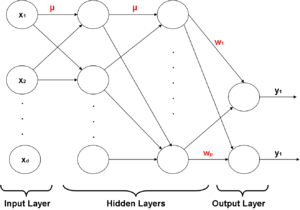
A regression problem typically has only one unit in the output layer. In a k-class classification problem, there are usually k units in the output layer that each represent the probability of class k and each [math]\displaystyle{ \displaystyle y_k }[/math] is coded (0,1).
Activation Function
Activation Function is a term that is frequently used in classification by NN.
In perceptron, we have a "sign" function that takes the sign of a weighted sum of input features.
File:signfuncperceptron.png
The sign function is of the form File:signfunc1.png and is not continuous at 0. Thus, we replace it by a smooth function [math]\displaystyle{ \displaystyle \sigma }[/math] of the form File:signfunc2.png and call it the activation function.
The choice of this function [math]\displaystyle{ \displaystyle \sigma }[/math] is determined by the properties of the data and the assumed distribution of target variables, but for multiple binary classification problems [math]\displaystyle{ \sigma(a)=\frac {1}{1+e^{-a}} }[/math] (inverse-logit) form is often used.
There are some important properties for the activation function.
- Activation function is nonlinear. It can be shown that if the activation function of the hidden units is linear, a three-layer neural network is equivalent to a two layer one.
- Activation function saturate, which means there are maximum and minimum output value. This property ensures that the weights are bounded and therefore the searching time is limited.
- Activation function is continuous and smooth.
- Activation function is monotonical. This property is not necessary, since we know that RBF networks is also a kind of power model.
Note: A key difference between the perceptron and NN is that the neural network uses continuous nonlinearities in the units, for the purpose of differentiation, whereas the perceptron often uses a non-differentiable activation function. The neural network function is differentiable with respect to the network parameters so that a gradient descent method can be used in training. Moreover, perceptron is a linear classifier, while NN, by combining layers of perceptrons, is able to classify non-linear problems through proper training.
By assigning some weights to the connectors in the neural network (see diagram above) we weigh the input that comes into the perceptron, to get an output that in turn acts as an input to the next layer of perceptrons, and so on for each layer. This type of neural network is called Feed-Forward Neural Network. Applications to Feed-Forward Neural Networks include data reduction, speech recognition, sensor signal processing, and ECG abnormality detection, to name a few. <ref>J. Annema, Feed-Forward Neural Networks, (Springer 1995), pp. 9 </ref>
Back-propagation
For a while, the Neural Network model was just an idea, since there were no algorithms for training the model until 1986, when Geoffrey Hinton <ref> http://www.cs.toronto.edu/~hinton/backprop.html </ref> came up with an algorithm called back-propagation. After that, a number of other training algorithms and various configurations of Neural Networks were implemented.
When we were talking about perceptrons, we applied gradient descent algorithm for optimizing the weights. Back-propagation uses this idea of gradient descent to train neural network based on the chain rule in calculus.
Assume that last output layer has only one unit, so we are working with a regression problem. Later we will see how this can be extended to more output layers and thus turn into a classificaiton problem.
For simplicity, there is only 1 unit at the end and assume for the moment we are doing regression.
Note that we make a distinction between the input weights [math]\displaystyle{ \displaystyle (w_i) }[/math] and hidden weights [math]\displaystyle{ \displaystyle (u_i) }[/math].
Within each perceptron we have a function [math]\displaystyle{ \displaystyle z_i=\sigma(a_i) }[/math] that takes input [math]\displaystyle{ \displaystyle a_i }[/math] and outputs [math]\displaystyle{ \displaystyle z_i's }[/math]. The [math]\displaystyle{ \displaystyle z_i's }[/math] are the inputs into the final output of the model [math]\displaystyle{ \Rightarrow \hat y_i=\sum_{i=1}^p w_i z_i }[/math]
We can find the error of the neural network output by evaluating the squared difference between the true classification and the resulting classification output [math]\displaystyle{ \Rightarrow \displaystyle error=||y-\hat y ||^2 }[/math]
First find derivative of the model error with respect to output weights [math]\displaystyle{ \displaystyle w_i }[/math]
[math]\displaystyle{ \frac{\partial err}{\partial w_i}=\frac{\partial err}{\partial \hat y} \cdot \frac{\partial \hat y}{\partial w_i} }[/math]
[math]\displaystyle{ \frac{\partial err}{\partial w_i}=2(y-\hat y) \cdot z_i }[/math]
Now we need to find the derivative of the model error with respect to hidden weights [math]\displaystyle{ \displaystyle u_i's }[/math]
Consider the following diagram that opens up the hidden layers of the neural network:
i j are reversed!
Notice that the weighted sum on the output of the perceptrons at layer [math]\displaystyle{ \displaystyle l }[/math] are the inputs into the perceptrons at layer [math]\displaystyle{ \displaystyle j }[/math] and so on for all hidden layers.
So, using the chain rule
[math]\displaystyle{ \frac{\partial err}{\partial u_{jl}}=\frac{\partial err}{\partial a_j} \cdot \frac{\partial a_j}{\partial u_{jl}} }[/math]
[math]\displaystyle{ \frac{\partial err}{\partial u_{jl}}=\delta_j \cdot z_l }[/math]
Note that a change in [math]\displaystyle{ \,a_j }[/math] causes changes in all [math]\displaystyle{ \,a_i }[/math] in the next layer which the error based on, thus we need to sum over i in the chain:
[math]\displaystyle{ \delta_j = \frac{\partial err}{\partial a_j} = \sum_i \frac{\partial err}{\partial a_i} \cdot \frac{\partial a_i}{\partial a_j} =\sum_i \delta_i \cdot \frac{\partial a_i}{\partial a_j} }[/math]
[math]\displaystyle{ \,\frac{\partial a_i}{\partial a_j}=\frac{\partial a_i}{\partial z_j} \cdot \frac{\partial z_j}{\partial a_j}=u_{ij} \cdot \sigma'(a_j) }[/math] Using the activation function [math]\displaystyle{ \,\sigma(\cdot) }[/math]
So [math]\displaystyle{ \delta_j = \sum_i \delta_i \cdot u_{ij} \cdot \sigma'(a_j) }[/math]
[math]\displaystyle{ \delta_j = \sigma'(a_j)\sum_i \delta_i \cdot u_{ij} }[/math]
Having calculated the error that the output creates, we can propagate this error back to the previous layers while adjusting the weights to solve a particular problem.
Neural Networks (NN) - October 30, 2009
Back-propagation
The idea is that we first feed an input from the training set to the Neural Network, then find the error rate at the output and then we propagate the error to previous layers and for each edge of weight [math]\displaystyle{ \,u_{ij} }[/math] we find [math]\displaystyle{ \frac{\partial \mathrm{err}}{\partial u_{ij}} }[/math]. Having the error rates at hand we adjust the weight of each edge by taking steps proportional to the negative of the gradient to decrease the error at output. The next step is to apply the next input from the training set and go through the described adjustment procedure. The overview of Back-propagation algorithm:
- Feed a point [math]\displaystyle{ \,x }[/math] in the training set to the network, and find the output of all the nodes.
- Evaluate [math]\displaystyle{ \,\delta_k=y_k-\hat{y_k} }[/math] for all output units, where [math]\displaystyle{ y_k }[/math] is the expected output and [math]\displaystyle{ \hat{y_k} }[/math] is the real output.
- By propagating to the previous layers evaluate all [math]\displaystyle{ \,\delta_j }[/math]s for hidden units: [math]\displaystyle{ \,\delta_j=\sigma'(a_j)\sum_i \delta_i u_{ij} }[/math] where [math]\displaystyle{ i }[/math] is associated to the previous layer.
- Using [math]\displaystyle{ \frac{\partial \mathrm{err}}{\partial u_{jl}} = \delta_j\cdot z_l }[/math] find all the derivatives.
- Adjust each weight by taking steps proportional to the negative of the gradient: [math]\displaystyle{ u_{jl}^{\mathrm{new}} \leftarrow u_{jl}^{\mathrm{old}} -\rho \frac{\partial \mathrm{err}}{u_{ij}} }[/math]
- Feed the next point in the training set and repeat the above steps.
How to initialize the weights
This still leaves the question of how to initialize the weights [math]\displaystyle{ \,u_{ij}, w_i }[/math]. The method of choosing weights mentioned in class was to randomize the weights before the first step. This is not likely to be near the optimal solution in every case, but is simple to implement. To be more specific, random values near zero will be a good choice for the initial weights. In this case, the model evolves from a nearly linear one to a nonlinear one as we desired. An alternative is to use an orthogonal least squares method to find the initial weights <ref>http://www.mitpressjournals.org/doi/abs/10.1162/neco.1995.7.5.982</ref>. Regression is performed on the weights and output by using a linear approximation of [math]\displaystyle{ \,\sigma(a_i) }[/math], and finds optimal weights in the linear model. Back propagation is used afterward to find the optimal solution, since the NN is non-linear.
How to set learning rates
The learning rate [math]\displaystyle{ \,\rho }[/math] is usually a constant.
If we use On-line learning, as a form of stochastic approximation process, [math]\displaystyle{ \,\rho }[/math] should decrease as the iteration increase.
Here we will mainly discuss how to estimate the number of hidden units at very beginning. Obviously, we should adjust it to be more precise using CV, LOO or other complexity control methods.
Basically, if the patterns are well separated, few hidden units are fairly enough. If the patterns are drawn from some highly complicated mixture models, more hidden units are really needed.
Actually, the number of hidden units determines the size of the model, and therefore the total number of the weights in the model. Typically speaking, the number of weights should not be larger than the number of training data, say N. Thus, sometimes, N/10 is a good choice. However, in pratice, many well performed models will use more hidden units.
Dimensionality reduction application
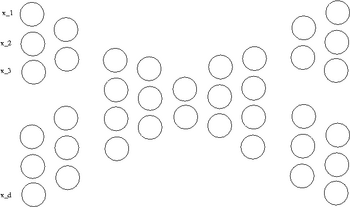
One possible application of Neural Networks is to perform dimensionality reduction, like other techniques, e.g., PCA, MDS, LLE and Isomap.
Consider the following configuration as shown in figure 1: As we go forward in layers of this Neural Network, the number of nodes is reduced, until we reach a layer with the number of nodes representing the desired dimensionality. However, note that at the very first few layers the number of nodes may not be strictly decreasing, as long as finally it can reach a layer with less nodes. From now on in the Neural Network the previous layers are mirrored. So at the output layer we have the same number of states as we have in the input layer. Now note that if we feed the network with each point and get an output approximately equal to the fed input, that means at the output the same input is reconstructed from the middle layer units. So the output of the middle layer units can represent the input with less dimensions.
To train this Neural Network, we feed the network with a training point and through back propagation we adjust the network weights based on the error between the input layer and the reconstruction at the output layer. Our low dimensional mapping will be the observed output from the middle layer. Data reconstruction consists of putting the low dimensional data through the second half of the network.
Deep Neural Network
Back-propagation in practice may not work well when there are too many hidden layers, since the [math]\displaystyle{ \,\delta }[/math] may become negligible and the errors vanish. This is a numerical problem, where it is difficult to estimate the errors. So in practice configuring a Neural Network with Back-propagation faces some subtleties. Deep Neural Networks became popular two or three years ago, when introduced by Bradford Nill in his PhD thesis. Deep Neural Network training algorithm deals with the training of a Neural Network with a large number of layers.
The approach of training the deep network is to assume the network has only two layers first and train these two layers. After that we train the next two layers, so on and so forth.
Although we know the input and we expect a particular output, we do not know the correct output of the hidden layers, and this will be the issue that the algorithm mainly deals with. There are two major techniques to resolve this problem: using Boltzman machine to minimize the energy function, which is inspired from the theory in atom physics concerning the most stable condition; or somehow finding out what output of the second layer is most likely to lead us to the expected output at the output layer.
Neural Networks in Practice
Now that we know so much about Neural Networks, what are suitable real world applications? Neural Networks have already been successfully applied in many industries.
Since neural networks are good at identifying patterns or trends in data, they are well suited for prediction or forecasting needs, such as customer research, sales forecasting, risk management and so on.
Take a specific marketing case for example. A feedforward neural network was trained using back-propagation to assist the marketing control of airline seat allocations. The neural approach was adaptive to the rule. The system is used to monitor and recommend booking advice for each departure.
Issues with Neural Network
When Neural Networks was first introduced they were thought to be modeling human brains, hence they were given the fancy name "Neural Network". But now we know that they are just logistic regression layers on top of each other but have nothing to do with the real function principle in the brain.
We do not know why deep networks turn out to work quite well in practice. Some people claim that they mimic the human brains, but this is unfounded. As a result of these kinds of claims it is important to keep the right perspective on what this field of study is trying to accomplish. For example, the goal of machine learning may be to mimic the 'learning' function of the brain, but necessarily the processes the brain uses to learn.
As for the algorithm, since it does not have a convex form, we still face the problem of local minimum, although people have devised other techniques to avoid this dilemma.
In sum, Neural Network lacks a strong learning theory to back up its "success", thus it's hard for people to wisely apply and adjust it. Having said that, it is not an active research area in machine learning. NN still has wide applications in the engineering field such as in control.
Complexity Control October 30, 2009
There are two issues that we have to avoid in Machine Learning:
- Overfitting
- Underfitting
Overfitting occurs when our model is heavily complex with so many degrees of freedom, that we can learn every detail of the training set. Such a model will have very high precision on the training set but will show very poor ability to predict outcomes of new instances, especially outside the domain of the training set.
In a Neural Network if the depth is too much, the network will have many degrees of freedom and will learn every characteristic of the training data set. That means it will show a very precise outcome of the training set but will not be able to generalize the commonality of the training set to predict the outcome of new cases.
Underfitting occurs when the model we picked to describe the data is not complex enough, and has high error rate on the training set. There is always a trade-off. If our model is too simple, underfitting could occur and if it is too complex, overfitting can occur.
Example
- Consider the example showed in the figure. We have a training set and we want to find a model which fits it the best. We can find a polynomial of high degree which almost passes through all the points in the training set. But, in fact the training set is coming from a line model. Now the problem is although the complex model has less error on the training set it diverges from the line in other ranges which we have no training point. Because of that the high degree polynomail has very poor predictive result on test cases. This is an example of overfitting model.
- Now consider a training set which comes from a polynomial of degree two model. If we model this training set with a polynomial of degree one, our model will have high error rate on the training set, and is not complex enough to describe the problem.
- Consider a simple classification example. If our classification rule takes as input only the colour of a fruit and concludes that it is a banana, then it is not a good classifier. The reason is that just because a fruit is a yellow, does not mean that it is a banana. We can add complexity to our model to make it a better classifier by considering more features typical of bananas, such as size and shape. If we continue to make our model more and more complex in order to improve our classifier, we will eventually reach a point where the quality of our classifier no longer improves, ie., we have overfit the data. This occurs when we have considered so many features that we have perfectly described the existing bananas, but if presented with a new banana of slightly different shape than the existing bananas, for example, it cannot be detected. This is the tradeoff; what is the right level of complexity?
Complexity Control - Nov 2, 2009
Overfitting occurs when the model becomes too complex and underfitting occurs when it is not complex enough, both of which are not desirable. To control complexity, it is necessary to make assumptions for the model before fitting the data. Assumptions that we can make for a model are with polynomials or a neural network. There are other ways as well.
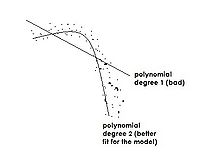
We do not want a model to get too complex, so we control it by making an assumption on the model. With complexity control, we want a model or a classifier with a low error rate.
How do we choose a good classifier?
Our goal is to find a classifier that minimizes the true error rate. Recall the empirical error rate
[math]\displaystyle{ \, L_{h}= \frac{1}{n} \sum_{i=1}^{n} I(h(x_{i}) \neq y_{i}) }[/math]
[math]\displaystyle{ \,h }[/math] is a classifier and we want to minimize the error rate. So we apply [math]\displaystyle{ \displaystyle x_1 }[/math] to [math]\displaystyle{ \displaystyle x_n }[/math] to [math]\displaystyle{ \displaystyle h }[/math], and take the average to get the empirical true error rate estimation of probability that [math]\displaystyle{ h(x_{i}) \neq y_{i} }[/math].
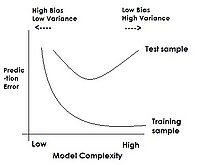
There is a downward bias to this estimate meaning that it is always less than the true error rate.
If there is a change in our complexity from low to high, our error rate is always decreasing. When we apply our model to the test data, our error rate will start to decrease to a point, but then it will increase since the model hasn't seen it before. This can be explained since training error will decrease when we fit the model better by increasing its complexity, but as we have seen, this complex model will not generalize well, resulting in a larger test error.
We use our test data (from the test sample line shown on Figure 2) to get our empirical error rate. Right complexity is defined as where error rate of the test data is minimum; and this is one idea behind complexity control.
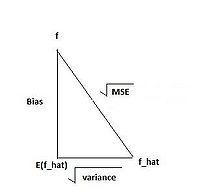
We assume that we have samples [math]\displaystyle{ \,X_1, . . . ,X_n }[/math] that follow some (possibly unknown) distribution. We want to estimate a parameter [math]\displaystyle{ \,f }[/math] of the unknown distribution. This parameter may be the mean [math]\displaystyle{ \,E(X_i) }[/math], the variance [math]\displaystyle{ \,var(X_i) }[/math] or some other quantity.
The unknown parameter [math]\displaystyle{ \,f }[/math] is a fixed real number [math]\displaystyle{ f\in R }[/math]. To estimate it, we use an estimator which is a function of our observations, [math]\displaystyle{ \hat{f}(X_1,...,X_n) }[/math].
[math]\displaystyle{ Bias (\hat{f}) = E(\hat{f}) - f }[/math]
[math]\displaystyle{ MSE (\hat{f}) = E[(\hat{f} - f)^2] }[/math]
[math]\displaystyle{ Variance (\hat{f}) = E[(\hat{f} - E(\hat{f}))^2] }[/math]
One property we desire of the estimator is that it is correct on average, that is, it is unbiased. [math]\displaystyle{ Bias (\hat{f}) = E(\hat{f}) - f=0 }[/math]. However, there is a more important property for an estimator than just being unbiased: the mean squared error. It reflects the error that the estimator makes.
Hence, our goal is to minimize [math]\displaystyle{ MSE (\hat{f}) }[/math].
From figure 3, we can see that the relationship of the three parameters is: [math]\displaystyle{ MSE (\hat{f})=Variance (\hat{f})+Bias ^2(\hat{f}) }[/math]. Thus given the Mean Squared Error (MSE), if we have a low bias, then we will have a high variance and vice versa.
A Test error is a good estimation on MSE. We want to have a somewhat balanced bias and variance (not high on bias or variance), although it will have some bias.
Referring to Figure 2, overfitting happens after the point where training data (training sample line) starts to decrease and test data (test sample line) starts to increase. There are 2 main approaches to avoid overfitting:
1. Estimating error rate
[math]\displaystyle{ \hookrightarrow }[/math] Empirical training error is not a good estimation
[math]\displaystyle{ \hookrightarrow }[/math] Empirical test error is a better estimation
[math]\displaystyle{ \hookrightarrow }[/math] Cross-Validation is fast
[math]\displaystyle{ \hookrightarrow }[/math] Computing error bound (analytically) using some probability inequality.
We will not discuss computing the error bound in class; however, a popular method for doing this computation is called VC Dimension (short for Vapnik–Chervonenkis Dimension). Information can be found from Andrew Moore and Steve Gunn.
2. Regularization
[math]\displaystyle{ \hookrightarrow }[/math] Use of shrinkage method
[math]\displaystyle{ \hookrightarrow }[/math] Decrease the chance of overfitting by controlling the weights
Example of under and overfitting in R
To give further intuition of over and underfitting, consider this example. A simple quadratic data set with some random noise is generated, and then polynomials of varying degrees are fitted. The errors for the training set and a test set are calculated.
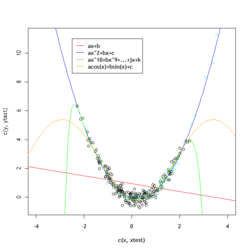
>> x <- rnorm(200,0,1) >> y <- x^2-0.5*x+rnorm(200,0,0.3) >> xtest <- rnorm(50,1,1) >> ytest <- xtest^2-0.5*xtest+rnorm(50,0,0.3) >> p1 <- lm(y~x) >> p2 <- lm(y ~ poly(x,2)) >> pn <- lm(y ~ poly(x,10)) >> psi <- lm(y~I(sin(x))+I(cos(x)))
xvalues for the training set are based on a [math]\displaystyle{ \,N(0,1) }[/math] distribution, while the test set has a [math]\displaystyle{ \,N(1,1) }[/math] distribution.yvalues are determined by [math]\displaystyle{ \,y = x^2 + x + N(0,0.3) }[/math], a quadratic function with some random variation. Polynomial least square fits of degree 1, 2, and 10 are calculated, as well as a fit of [math]\displaystyle{ \,sin(x)+cos(x) }[/math].
>> > # calculate the mean squared error of degree 1 poly >> > sum((y-predict(p1,data.frame(x)))^2)/length(y) >> [1] 1.576042 >> > sum((ytest-predict(p1,data.frame(x=xtest)))^2)/length(ytest) >> [1] 7.727615
- Training and test mean squared errors for the linear fit. These are both quite high - and since the data is non-linear, the different mean value of the test data increases the error quite a bit.
>> > # calculate the mean squared error of degree 2 poly >> > sum((y-predict(p2,data.frame(x)))^2)/length(y) >> [1] 0.08608467 >> > sum((ytest-predict(p2,data.frame(x=xtest)))^2)/length(ytest) >> [1] 0.08407432
- This fit is far better - and there is not much difference between the training and test error, either.
>> > # calculate the mean squared error of degree 10 poly >> > sum((y-predict(pn,data.frame(x)))^2)/length(y) >> [1] 0.07967558 >> > sum((ytest-predict(pn,data.frame(x=xtest)))^2)/length(ytest) >> [1] 156.7139
- With a high-degree polynomial, the training error continues to decrease, but not by much - and the test set error has risen again. The overfitting makes it a poor predictor. As the degree of the polynomial rises further, the accuracy of the computer becomes an issue - and a good fit is not even consistently produced for the training data.
>> > # calculate mse of sin/cos fit >> > sum((y-predict(psi,data.frame(x)))^2)/length(y) >> [1] 0.1105446 >> > sum((ytest-predict(psi,data.frame(x=xtest)))^2)/length(ytest) >> [1] 1.320404
- Fitting a function of the form sin(x)+cos(x) works pretty well on the training set, but because it is not the real underlying function, it fails on test data which doesn't lie on the same domain.
Cross-Validation (CV) - Introduction

Cross-Validation is used to estimate the error rate of a classifier with respect to test data rather than data used in the model. Here is a general introduction to CV:
[math]\displaystyle{ \hookrightarrow }[/math] We have a set of collected data for which we know the proper labels
[math]\displaystyle{ \hookrightarrow }[/math] We divide it into 2 parts, Training data (T) and Validation data (V)
[math]\displaystyle{ \hookrightarrow }[/math] For our calculation, we pretend that we do not know the label of V and we use data in T to train the classifier
[math]\displaystyle{ \hookrightarrow }[/math] We estimate an empirical error rate on V since the model hasn't seen V yet and we know the proper label of all elements in V to know how many were misclassified.
CV has different implementations which can reduce the variance of the calculated error rate, but sometimes with a tradeoff of a higher calculation time.
Complexity Control - Nov 4, 2009
Cross-validation
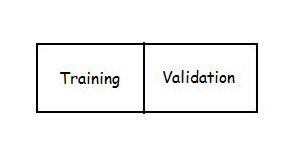
Cross-validation is the simplest and most widely used method to estimate the true error. It comes from the observation that although training error always decreases with the increasing complexity of the model, the test error starts to increase from a certain point, which is noted as overfitting (see figure 2 above). Since test error estimates MSE (mean square error) best, people came up with the idea to randomly separate the data set into a training set and a validation set, which is used to simulate a test set.
Then, we only use the section of our data marked as the "training set" to train our algorithm, while keeping the section of our data marked as the "validation set" untouched. As a result, the validation set will be totally unknown to the trained model. The error rate is then estimated by:
[math]\displaystyle{ \hat L(h) = \frac{1}{|\nu|}\sum_{X_i \in \nu}(h(x_i) \neq y_i) }[/math], where [math]\displaystyle{ \,|\nu| }[/math] is the cardinality of the validation set.
When we change the complexity, the error generated by the validation set will have the same behavior as the test set, so we are able to choose the best parameters to get the lowest error.
K-fold Cross-validation
Above is the simplest form of complexity control. However, in reality, it may be hard to collect data ??and we usually suffer from the curse of dimensionality??, and a larger data set may be hard to come by. Consequently, we may not be able to afford to sacrifice part of the limited resources. In this case we use another method that addresses this problem, K-fold cross-validation. We divide the data set into [math]\displaystyle{ \,K }[/math] subsets roughly equal in size. The usual choice is [math]\displaystyle{ \,K = 10 }[/math].
Generally, how to choose [math]\displaystyle{ \,K }[/math]:
if [math]\displaystyle{ \,K=n }[/math], leave one out, low bias, high variance. Each subset contains a single element, so the model is trained with all except one point, and then validated using that point.
if [math]\displaystyle{ \,K=2 }[/math], say 2-fold, 5-fold, high bias, low variance. Each subset contains approximately [math]\displaystyle{ \,\frac{1}{2} }[/math] or [math]\displaystyle{ \,\frac{1}{5} }[/math] of the data.
For every [math]\displaystyle{ \,k }[/math]th [math]\displaystyle{ ( \,k \in [ 1, K ] ) }[/math] part, we use the other [math]\displaystyle{ \,K-1 }[/math] parts to fit the model and test on the [math]\displaystyle{ \,k }[/math]th part to estimate the prediction error [math]\displaystyle{ \hat L_k }[/math], where
[math]\displaystyle{ \hat L(h) = \frac{1}{K}\sum_{k=1}^K\hat L_k }[/math]
For example, suppose we want to fit a polynomial model to the data set and split the set into four equal subsets as shown in Figure 2. First we choose the degree to be 1, i.e. a linear model. Next we use the first three sets as training sets and the last as validation set, then the 1st, 2nd, 4th subsets as training set and the 3rd as validation set, so on and so forth until all the subsets have been the validation set once (all observations are used for both training and validation). After we get [math]\displaystyle{ \hat L_1, \hat L_2, \hat L_3, \hat L_4 }[/math], we can calculate the average [math]\displaystyle{ \hat L }[/math] for degree 1 model. Similarly, we can estimate the error for n degree model and generate a simulating curve. Now we are able to choose the right degree which corresponds to the minimum error. Also, we can use this method to find the optimal unit number of hidden layers of neural networks. We can begin with 1 unit number, then 2, 3 and so on and so forth. Then find the unit number of hidden layers with lowest average error.
Generalized Cross-validation
If the vector of observed values is denoted by [math]\displaystyle{ \mathbf{y} }[/math], and the vector of fitted values by [math]\displaystyle{ \hat\mathbf{y} }[/math].
[math]\displaystyle{ \mathbf{y} = \mathbf{H}\hat\mathbf{y} }[/math],
where the hat matrix is given by
[math]\displaystyle{ \mathbf{H} = \mathbf{X}( \mathbf{X}^{T} \mathbf{X})^{-1}\mathbf{X}^{T} }[/math],
[math]\displaystyle{ \frac{1}{N}\sum_{i=1}^{N}[y_{i} - \hat f^{-i}(\mathbf{x}_{i})]^{2}=\frac{1}{N}\sum_{i=1}^{N}[\frac{y_{i}-\hat f(x_{i})}{1-\mathbf{H}_{ii}}]^{2} }[/math],
Then the GCV approximation is given by
[math]\displaystyle{ GCV(\hat f) = \frac{1}{N}\sum_{i=1}^{N}[\frac{y_{i}-\hat f(x_{i})}{1-trace(\mathbf{H})/N}]^{2} }[/math],
Thus, one of the biggest advantages of the GCV is that the trace is more easily computed.
Leave-one-out Cross-validation
Leave-one-out cross-validation involves using all but one data point in the original training data set to train our model, then using the data point that we initially left out as a means to estimate true error. But repeating this process for every data point in our original data set, we can obtain a good estimation of true error.
In other words, leave-one-out cross-validation is k-fold cross-validation in which we set the subset number [math]\displaystyle{ \,K }[/math] to be the cardinality of the whole data set.
In the above example, we can see that k-fold cross-validation can be computationally expensive: for every possible value of the parameter, we must train the model [math]\displaystyle{ \,K }[/math] times. This deficiency is even more obvious in leave-one-out cross-validation, where we must train the model [math]\displaystyle{ \,n }[/math] times, where [math]\displaystyle{ \,n }[/math] is the number of data point in the data set.
Fortunately, when adding data points to the classifier is reversible, calculating the difference between two classifiers is computationally more efficient than calculating the two classifiers separately. So, if the classifier on all the data points is known, we simply undo the changes from a data point [math]\displaystyle{ \,K }[/math] times to calculate the leave-one-out cross-validation error rate.
Regularization for Neural Network — Weight Decay
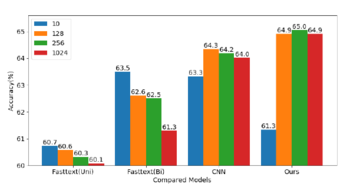
Weight decay training is suggested as an implementation for achieving a robust neural network which is insensitive to noise. Since the number of hidden layers in NN is usually decided by certain domain knowledge, it may easily get into the problem of overfitting.
It can be seen from Figure 1 that when the weight is in the vicinity of zero, the operative part of the activation function shows linear behavior. The NN then collapses to an approximately linear model. Note that a linear model is the simplest model, we can avoid overfitting by constraining the weights to be small. This gives us a hint to initialize the random weights to be close to zero.
Formally, we penalize nonlinear weights by adding a penalty term in the error function. Now the regularized error function becomes:
[math]\displaystyle{ \,REG = err + \lambda(\sum_{i}|w_i|^2 + \sum_{jk}|u_{jk}|^2) }[/math], where [math]\displaystyle{ \,err }[/math] is the original error in back-propagation; [math]\displaystyle{ \,w_i }[/math] is the weights of the output layer; [math]\displaystyle{ \,u_{jk} }[/math] is the weights of the hidden layers.
Usually, too large [math]\displaystyle{ \,\lambda }[/math] will make the weights [math]\displaystyle{ \,w_i }[/math] and [math]\displaystyle{ \,u_{jk} }[/math] too small. We can use cross validation to estimate [math]\displaystyle{ \,\lambda }[/math].
A similar penalty, weight elimination, is given by,
[math]\displaystyle{ \,REG = err + \lambda(\sum_{i}\frac{|w_i|^2}{1 + |w_i|^2} + \sum_{jk}\frac{|u_{jk}|^2}{1+|u_{jk}|^2}) }[/math].
As in back-propagation, we take partial derivative with respect to the weights:
[math]\displaystyle{ \frac{\partial REG}{\partial w_i} = \frac{\partial err}{\partial w_i} + 2\lambda w_i }[/math]
[math]\displaystyle{ \frac{\partial REG}{\partial u_{jk}} = \frac{\partial err}{\partial u_{jk}} + 2\lambda u_{jk} }[/math]
[math]\displaystyle{ w^{new} \leftarrow w^{old} - \rho\left(\frac{\partial err}{\partial w} + 2\lambda w\right) }[/math]
[math]\displaystyle{ u^{new} \leftarrow u^{old} - \rho\left(\frac{\partial err}{\partial u} + 2\lambda w\right) }[/math]
Note that here [math]\displaystyle{ \,\lambda }[/math] serves as a trade-off parameter, tuning between the error rate and the linearity. Actually, we may also set [math]\displaystyle{ \,\lambda }[/math] by cross-validation. The tuning parameter is important since weights of zero will lead to zero derivatives and the algorithm will not change. On the other hand, starting with weights that are too large means starting with a nonlinear model which can often lead to poor solutions. <ref>Trevor Hastie, Robert Tibshirani, Jerome Friedman, Elements of Statistical Learning (Springer 2009) pp.398</ref>
Radial Basis Function (RBF) Networks - November 6, 2009
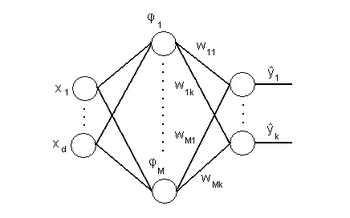
Introduction
A Radial Basis Function (RBF) network is a type of artificial neural network with an output layer and a single hidden layer, with weights from the hidden layer to the output layer, and can be trained without back propagation. The neurons in the hidden layer contain basis function. One choice that has been widely used is that of radial basis functions, which have the property that each basis function depends only on the radial distance(typically Euclidean) from a center [math]\displaystyle{ \displaystyle\mu_{j} }[/math], so that [math]\displaystyle{ \phi_{j}(x)= h({\Vert x - \mu_{j}\Vert}) }[/math]. The most common form of basis function is radial basis function or Gaussian functions.
The output of an RBF network can be expressed as a weighted sum of its radial basis functions as follows:
[math]\displaystyle{ \hat y_{k} = \sum_{j=1}^M\phi_{j}(x) w_{jk} }[/math]
The radial basis function is:
[math]\displaystyle{ \phi_{j}(x) = e^{\frac{-\Vert x - \mu_{j}\Vert ^2}{2\sigma_{j}^2}} }[/math]
note:The hidden layer has a variable number of neurons (the optimal number is determined by the training process). The more the number of neurons, the more complex the model is. Each neuron consists of a radial basis function centered on a point with the same dimensions as the input data. The radius of the RBF function may be different. The centers and radius are determined by the training process. When the x vector is given from the input layer, the hidden neuron computes the Euclidean distance from the neuron’s center point and then applies RBF function to this distance using the radius. The resulting value is passed to the the output layer.
[math]\displaystyle{ \,y_{k} }[/math] can be expressed in matrix form as:
[math]\displaystyle{ \hat Y = \Phi W }[/math]
where
- [math]\displaystyle{ \hat Y = \left[ \begin{matrix} y_{11} & y_{12} & \cdots & y_{1k} \\ y_{21} & y_{22} & \cdots & y_{2k} \\ \vdots & & \ddots & \vdots \\ y_{n1} & y_{n2} & \cdots & y_{nk} \end{matrix}\right] }[/math] is the matrix of output variables.
- [math]\displaystyle{ \Phi = \left[ \begin{matrix} \phi_{11} & \phi_{12} & \cdots & \phi_{1M} \\ \phi_{21} & \phi_{22} & \cdots & \phi_{2M} \\ \vdots & & \ddots & \vdots \\ \phi_{n1} & \phi_{n2} & \cdots & \phi_{nM} \end{matrix}\right] }[/math] is the matrix of Radial Basis Functions.
- [math]\displaystyle{ W = \left[ \begin{matrix} w_{11} & w_{12} & \cdots & w_{1k} \\ w_{21} & w_{22} & \cdots & w_{2k} \\ \vdots & & \ddots & \vdots \\ w_{M1} & w_{M2} & \cdots & w_{Mk} \end{matrix}\right] }[/math] is the matrix of weights.
Here, [math]\displaystyle{ k }[/math] is the number of classifiers, [math]\displaystyle{ n }[/math] is the number of data points, and [math]\displaystyle{ M }[/math] is the number of hidden units. If [math]\displaystyle{ k = 2 }[/math], [math]\displaystyle{ \hat Y }[/math] and [math]\displaystyle{ W }[/math] are [math]\displaystyle{ n \times 2 }[/math]. As input [math]\displaystyle{ \,Y }[/math] is usually the class of 1 or 2 rather than probability of each class, to match with [math]\displaystyle{ \hat Y }[/math] make [math]\displaystyle{ Y_{i1} = 1 }[/math] if [math]\displaystyle{ Y_i = 1 }[/math], [math]\displaystyle{ Y_{i2} = 1 }[/math] if [math]\displaystyle{ Y_i = 2 }[/math].
Estimation of weight matrix W
We need to minimize the squared norm [math]\displaystyle{ \Vert Y - \Phi W\Vert^{2} }[/math] which represents the training error in order to find [math]\displaystyle{ \,W }[/math]. From a previous result in linear algebra we know that
[math]\displaystyle{ \Vert A \Vert^2 = Tr(A^{T}A) }[/math]
Thus we have
[math]\displaystyle{ \ Error = \Vert Y - \Phi W\Vert^{2} = Tr[(Y - \Phi W)^{T}(Y - \Phi W)] }[/math]
[math]\displaystyle{ \ Error = Tr[Y^{T}Y - Y^{T}\Phi W - W^{T} \Phi^{T} Y + W^{T}\Phi^{T} \Phi W] }[/math]
Useful properties of matrix differentiation
[math]\displaystyle{ \frac{\partial Tr(Ax)}{\partial x} = A^{T} }[/math]
[math]\displaystyle{ \frac{\partial Tr(x^{T}A)}{\partial x} = A }[/math]
[math]\displaystyle{ \frac{\partial Tr(x^{T}Ax)}{\partial x} = (A^{T} + A)x }[/math]
Solving for W
We can solve for [math]\displaystyle{ \,W }[/math] by setting [math]\displaystyle{ \frac{\partial err}{\partial W} }[/math] equal to zero and using the aforementioned properties of matrix differentiation.
[math]\displaystyle{ \frac{\partial err}{\partial W} = 0 }[/math]
[math]\displaystyle{ \ 0 - \Phi^{T}Y - \Phi^{T}Y + 2\Phi^{T}\Phi W = 0 }[/math]
[math]\displaystyle{ \ -2 \Phi^{T}Y + 2\Phi^{T}\Phi W = 0 }[/math]
[math]\displaystyle{ \ W = (\Phi^{T}\Phi)^{-1}\Phi^{T}Y }[/math]
[math]\displaystyle{ \hat{Y} = \Phi W = \Phi(\Phi^{T}\Phi)^{-1})\Phi^{T}Y = HY }[/math]
where [math]\displaystyle{ \ H = \Phi(\Phi^{T}\Phi)^{-1})\Phi^{T} }[/math]
[math]\displaystyle{ \,H }[/math] is the hat matrix for this model.
Including an additional bias
[math]\displaystyle{ \,y_{k} }[/math] can be expressed in matrix form as:
[math]\displaystyle{ \hat Y = \Phi W }[/math]
where
- [math]\displaystyle{ \hat Y = \left[ \begin{matrix} y_{11} & y_{12} & \cdots & y_{1k} \\ y_{21} & y_{22} & \cdots & y_{2k} \\ \vdots & & \ddots & \vdots \\ y_{n1} & y_{n2} & \cdots & y_{nk} \end{matrix}\right] }[/math] is the matrix(n by k) of output variables.
- [math]\displaystyle{ \Phi = \left[ \begin{matrix} \phi_{10} &\phi_{11} & \phi_{12} & \cdots & \phi_{1M} \\ \phi_{20} & \phi_{21} & \phi_{22} & \cdots & \phi_{2M} \\ \vdots & & \ddots & \vdots \\ \phi_{n0} &\phi_{n1} & \phi_{n2} & \cdots & \phi_{nM} \end{matrix}\right] }[/math] is the matrix(n by M+1) of Radial Basis Functions.
- [math]\displaystyle{ W = \left[ \begin{matrix} w_{01} & w_{02} & \cdots & w_{0k} \\ w_{11} & w_{12} & \cdots & w_{1k} \\ w_{21} & w_{22} & \cdots & w_{2k} \\ \vdots & & \ddots & \vdots \\ w_{M1} & w_{M2} & \cdots & w_{Mk} \end{matrix}\right] }[/math] is the matrix(M+1 by k) of weights.
where the extra basis function [math]\displaystyle{ \Phi_{0} }[/math] is set to 1.
Normalized RBF
In addition to the above unnormalized architecture, the normalized RBF can be represented as:
[math]\displaystyle{ y_{k}(X) = \frac{\sum_{j=1}^{M} w_{jk}\Phi_{j}(X)}{\sum_{r=1}^{M}\Phi_{r}(X)} }[/math]
Actually, [math]\displaystyle{ \Phi^{\ast}_{j}(X) = \frac{\Phi_{j}(X)}{\sum_{r=1}^{M}\Phi_{r}(X)} }[/math] is known as a normalized radial basis function.
RBF networks for classification -- a probabilistic paradigm
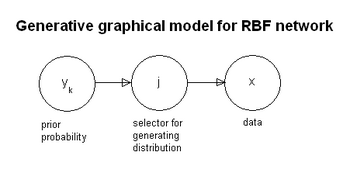
An RBF network is akin to fitting a Gaussian mixture model to data. We assume that each class can be modelled by a single function [math]\displaystyle{ \,\phi }[/math] and data is generated by a mixture model. According to Bayes Rule,
[math]\displaystyle{ Pr(Y = y_{k} | X = x) = \frac {Pr(x|y_{k})*Pr(y_{k})}{Pr(x)} }[/math]
While all classifiers that we have seen thus far in the course have been in discriminative form, the RBF network is a generative model that can be represented using a directed graph.
We can replace the class conditional density in the above conditional probability expression by marginalize [math]\displaystyle{ \,x }[/math] over [math]\displaystyle{ \,j }[/math]: [math]\displaystyle{ \Pr(x|y_{k}) = \sum_{j} Pr(x|j)*Pr(j|y_{k}) }[/math]
- Note We made the assumption that each class can be modelled by a single function [math]\displaystyle{ \displaystyle\Phi }[/math] and that the data was generated by a mixture model. The Gaussian mixture model has the form:
[math]\displaystyle{ f(x)=\sum_{m=1}^M \alpha_m \phi(x;\mu_m,\Sigma_m) }[/math] where [math]\displaystyle{ \displaystyle\alpha_m }[/math] are mixing proportions, [math]\displaystyle{ \displaystyle\sum_m \alpha_m=1 }[/math], and [math]\displaystyle{ \displaystyle\mu_m }[/math] and [math]\displaystyle{ \displaystyle\Sigma_m }[/math] are the mean and covariance of each Gaussian density respectively. <ref>H. Trevor, R. Tibshirani, J. Friedman, The Elements of Statistical Learning (Springer 2009), pp. 214. </ref> The generative model in Figure 1 shows graphically how each Gaussian in the mixture model is chosen to sample from.
Radial Basis Function (RBF) Networks - November 9th, 2009(Working in process!)
RBF Network for classification (A probabilistic point of view)
Using RBF Network to do classification, we usually treat it as regression problem. We want to put threshold to decide what the data’s class membership is. However, to find some insight to the classification problem of what we are doing in terms of RBF Network, we often think of mixture models and make certain assumptions.
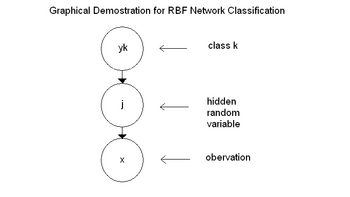
We assume, as we can see in the graph on the right hand side, we have three random variables, [math]\displaystyle{ \displaystyle y_k }[/math], [math]\displaystyle{ \displaystyle j }[/math], and [math]\displaystyle{ \displaystyle x }[/math]. [math]\displaystyle{ \displaystyle y_k }[/math] denotes class k; [math]\displaystyle{ \displaystyle x }[/math] is what we observed here, and [math]\displaystyle{ \displaystyle j }[/math] is some hidden random variable. There is a process that there are different classes, and each class can trigger a different hidden random variable [math]\displaystyle{ \displaystyle j }[/math]. To understand this, simply we can assume, for instance, this random variable [math]\displaystyle{ \displaystyle j }[/math] has a Gaussian distribution (it could have any other distributions as well). And, all the [math]\displaystyle{ \displaystyle j }[/math]’s have the same distributions(Gaussian), but with different parameters. From each Gaussian distribution trigged by each class, we are going to sample some data points. Therefore, in the end, we are going to get a set of data, which are not strictly Gaussian, but are actually mixture Gaussian.
Again, we use Bayes' Rule to look at the posterior distribution.
[math]\displaystyle{ Pr(Y = y_{k} | X = x) = \frac {Pr(X = x | Y = y_{k})*Pr(Y = y_{k})}{Pr(X = x)} }[/math]
Since we made the assumption that the data has been generated by a mixture model. By this mixture model, we can estimate this conditional probability by
[math]\displaystyle{ \Pr(X = x | Y = y_{k}) = \sum_{j} Pr(X = x | j)*Pr(j | Y = y_{k}) }[/math],
which is the class conditional distribution (or probability) of the mixture model. Note, here, if we only have a simple model from [math]\displaystyle{ \displaystyle y_k }[/math] to [math]\displaystyle{ \displaystyle x }[/math], then we won’t have this summation.
If this is the class conditional distribution, let us replace it to Bayes’ Rule and see what we can get. Basically, I can say that the posterior of class k is summation over j of the probability of [math]\displaystyle{ \displaystyle x }[/math] given [math]\displaystyle{ \displaystyle j }[/math] times the probability of [math]\displaystyle{ \displaystyle j }[/math] given [math]\displaystyle{ \displaystyle y_k }[/math], and times the prior distribution of class k, and lastly divided by the marginal probability of [math]\displaystyle{ \displaystyle x }[/math]. That is,
[math]\displaystyle{ \Pr(x | y_{k}) = \frac {\sum_{j} Pr(x | j)*Pr(j | y_{k})*Pr(y_{k})}{Pr(X = x)} }[/math].
Since, the prior probability of class k doesn’t have a index of [math]\displaystyle{ \displaystyle j }[/math], so it can be taken out of the summation, which yields,
[math]\displaystyle{ \Pr(x | y_{k}) = \frac {Pr(y_{k})\sum_{j} Pr(x | j)*Pr(j | y_{k})}{Pr(X = x)} }[/math].
We multiply this by [math]\displaystyle{ \displaystyle 1 = \frac {Pr(j)}{Pr(j)} }[/math]. Then, it becomes,
[math]\displaystyle{ \Pr(x | y_{k}) = \frac {Pr(y_{k})\sum_{j} Pr(x | j)*Pr(j | y_{k})}{Pr(X = x)} * \frac {Pr(j)}{Pr(j)} }[/math].
Now, we are going to look at these three quantities, [math]\displaystyle{ \displaystyle Pr(x | j) }[/math], [math]\displaystyle{ \displaystyle Pr(j) }[/math], and [math]\displaystyle{ \displaystyle Pr(x) }[/math];
[math]\displaystyle{ \displaystyle Pr(x | j) = \frac {Pr(x | j)*Pr(j)}{Pr(x)} }[/math]
and look at another three, [math]\displaystyle{ \displaystyle Pr(j | y_k) }[/math], [math]\displaystyle{ \displaystyle Pr(y_k) }[/math], and [math]\displaystyle{ \displaystyle Pr(j) }[/math].
[math]\displaystyle{ \displaystyle Pr(y_k | j) = \frac {Pr(j | y_k)*Pr(y_k)}{Pr(j)} }[/math]
Hence, we finally have the posterior
[math]\displaystyle{ \displaystyle Pr(y_k | x) = \sum_{j} Pr(j | x)Pr(y_k | j) }[/math].
Interpretation of RBF Network classification

We want relate the results that we derived above to our RBF Network. In a RBF Network, as we can see on the right hand side, we have a set of data, [math]\displaystyle{ \displaystyle x_1 }[/math] to [math]\displaystyle{ \displaystyle x_d }[/math], and the hidden basis function [math]\displaystyle{ \displaystyle \phi_{1} }[/math] to [math]\displaystyle{ \displaystyle \phi_{M} }[/math], and then we have some output from [math]\displaystyle{ \displaystyle y_1 }[/math], to [math]\displaystyle{ \displaystyle y_k }[/math]. Also, we have weights from the hidden layer to output layer. The output is just the linear sum of [math]\displaystyle{ \displaystyle \phi }[/math]’s.
Now consider probability of [math]\displaystyle{ \displaystyle j }[/math] given [math]\displaystyle{ \displaystyle x }[/math] to be [math]\displaystyle{ \displaystyle \phi }[/math], and the probability of [math]\displaystyle{ \displaystyle y_k }[/math] given [math]\displaystyle{ \displaystyle j }[/math] to be the weights [math]\displaystyle{ \displaystyle w_{jk} }[/math], then the posterior can be written as,
[math]\displaystyle{ \displaystyle Pr(y_k | x) = \sum_{j} \phi_{j}(x)*w_{jk} }[/math].

Now, let us look at an example in one dimensional case.
We know that [math]\displaystyle{ \displaystyle \phi }[/math] is a radial basis function. We put some Gaussian over data. And for each Gaussian, we consider the center µ. Then, what [math]\displaystyle{ \displaystyle \phi }[/math] computes is the similarity of any data point to the center.
For example,
[math]\displaystyle{ \phi_{j}(x) = e^{\frac{-\Vert x - \mu_{j}\Vert ^2}{2\sigma_{j}^2}} }[/math], and [math]\displaystyle{ \displaystyle j }[/math] is from 1 to 2.
We can see the graph on the left of the density of [math]\displaystyle{ \displaystyle \phi_{1} }[/math] and [math]\displaystyle{ \displaystyle \phi_{2} }[/math]. Take [math]\displaystyle{ \displaystyle \phi_{1} }[/math] for instance, if the point gets far from the center [math]\displaystyle{ \displaystyle \mu_{1} }[/math], then it will reduce [math]\displaystyle{ \displaystyle \phi_{1} }[/math] to become nearly zero. Remember that, we can usually find a non-linear regression or classification of input space by doing a linear one in some extended space or some feature space (more details in Aside). Here, the [math]\displaystyle{ \displaystyle \phi }[/math]’s actually produce that feature space.
So, one way to look at this is that this [math]\displaystyle{ \displaystyle \phi }[/math] is telling us that given an input, how likely is the probability of presence of this particular feature. Say, for instance, we define the features as the centers of these Gaussian distributions. Then, those [math]\displaystyle{ \displaystyle \phi }[/math]‘s somehow computes that, given certain data points, how possibly this kind of feature would appear. If the data point is right at the center, then the probability is 1, and if it’s far from the center, then the probability ([math]\displaystyle{ \displaystyle \phi }[/math] function value) will close to zero, that is, it’s less likely. Therefore, we can treat [math]\displaystyle{ \displaystyle Pr(j | x) }[/math] as the probability of particular feature given data.
When we have those features, then [math]\displaystyle{ \displaystyle y }[/math] is the linear combination of the features. Hence, any of the weights [math]\displaystyle{ \displaystyle w }[/math], which is equal to [math]\displaystyle{ \displaystyle Pr(y_k | j) }[/math], tells us how likely this particular [math]\displaystyle{ \displaystyle y }[/math] will appear given those features. Therefore, the weight [math]\displaystyle{ \displaystyle w_{jk} }[/math] shows the probability of class membership given feature.
Hence, we have found a probabilistic point of view to look at RBF Network!
Aside
- Feature Space:
- One way to produce a feature space is LDA
- Suppose, we have n data points [math]\displaystyle{ \mathbf{x}_1 }[/math] to [math]\displaystyle{ \mathbf{x}_n }[/math]. Each data point has d features. And these n data points consist of the [math]\displaystyle{ X }[/math] matrix,
- [math]\displaystyle{ X = \left[ \begin{matrix} x_{11} & x_{21} & \cdots & x_{n1} \\ x_{12} & x_{22} & \cdots & x_{n2} \\ \vdots & & \ddots & \vdots \\ x_{1d} & x_{2d} & \cdots & x_{nd} \end{matrix}\right] }[/math]
- Also, we have feature space,
- [math]\displaystyle{ \Phi^{T} = \left[ \begin{matrix} \phi_{1}(\mathbf{x_1}) & \phi_{1}(\mathbf{x_2})& \cdots & \phi_{1}(\mathbf{x_n})\\ \phi_{2}(\mathbf{x_1})& \phi_{2}(\mathbf{x_2})& \cdots & \phi_{2}(\mathbf{x_n}) \\ \vdots & & \ddots & \vdots \\ \phi_{M}(\mathbf{x_1}) & \phi_{M}(\mathbf{x_2}) & \cdots & \phi_{M}(\mathbf{x_n}) \end{matrix}\right] }[/math]
- We don’t perform Least Square on this [math]\displaystyle{ \displaystyle X }[/math] matrix, we do Least Square on the feature space, [math]\displaystyle{ \displaystyle i.e. }[/math] on the [math]\displaystyle{ \displaystyle \Phi^{T} }[/math] matrix. The dimensionality of [math]\displaystyle{ \displaystyle \Phi^{T} }[/math] is M by n.
- Now, we still have n data points, but we define these n data points in terms a new set of features. So, originally, we define our data points by d features, but now, we define them by M features. And what are those M features telling us?
- Let us look at the first column of [math]\displaystyle{ \displaystyle \Phi^{T} }[/math] matrix. The first entry is [math]\displaystyle{ \displaystyle \phi_1 }[/math] applying to [math]\displaystyle{ \mathbf{x_1} }[/math], so on until the last entry is [math]\displaystyle{ \displaystyle \phi_M }[/math] applying to [math]\displaystyle{ \mathbf{x_1} }[/math]. Suppose each this [math]\displaystyle{ \displaystyle \phi_j }[/math] is defined by
- [math]\displaystyle{ \phi_{j}(x) = e^{\frac{-\Vert x - \mu_{j}\Vert ^2}{2\sigma_{j}^2}} }[/math].
- Then, each [math]\displaystyle{ \displaystyle \phi_j }[/math] checks the similarity of the data point with its center. Hence, the new set of features are actually representing M centers in our data set, and for each data point, its new features check how this point is similar to the first center; how it is similar to the second center; and how it is similar to the [math]\displaystyle{ \displaystyle M^{th} }[/math] center. And this checking process will apply to all data points. Therefore, feature space gives another representation of our data set.
Model selection or complexity control for RBF Network - a brief introduction
In order to obtain a better fit for the training data, we often want to increase the complexity of our RBF Network. By its construction, we know that to change the complexity of a RBF Network, the only way is to add or decrease the number of basis functions. A large number of basis functions yields a more complex network. If we add enough basis functions, the RFB Network can work for any training; however, it doesn't mean this RBF Network model can generalize well. Therefore, for the purpose of avoiding overfitting problem (see Notes below), we only want to increase the number of basis functions to certain point, [math]\displaystyle{ \displaystyle i.e. }[/math] its optimal level.
For the model selection, what we usually do is estimating the training error. After working through the training error, we’ll see that the training error in fact can be decomposed, and one component of training error is called Mean Squared Error (MSE). In the later notes, we will find that our final goal is to get a good estimate of MSE. Moreover, in order to find an optimal model for our data, we select the model with the smallest MSE.
Now, let us introduce some notations that we will use in the analysis:
- [math]\displaystyle{ \hat f }[/math] -- the prediction model estimated by a RBF network from the training data
- [math]\displaystyle{ \displaystyle f }[/math] -- the real model (not null), and ideally, we want [math]\displaystyle{ \hat f }[/math] is close to [math]\displaystyle{ \displaystyle f }[/math]
- [math]\displaystyle{ \displaystyle err }[/math] -- the training error
- [math]\displaystyle{ \displaystyle Err }[/math] -- the testing error
- [math]\displaystyle{ \displaystyle MSE }[/math] -- the Mean Squared Error
Notes
- Being more complex isn’t always a good thing. Sometime, overfitting makes the model to lose its generality. For example in the graph on left hand side, the data points are sampled from the model [math]\displaystyle{ \displaystyle y_i= f(x_i)+\epsilon_i }[/math], where [math]\displaystyle{ \displaystyle f(x_i) }[/math] is a linear function, which is shown by the blue line, and [math]\displaystyle{ \displaystyle \epsilon_i }[/math]is additive Gaussian noise from [math]\displaystyle{ ~N(0,\sigma^2) }[/math]. The red curve displayed in the graph shows the over-fitted model. Clearly, this over-fitted model only works for any training data, and is useless for any further prediction for introducing new data points.
> n<-20; > x<-seq(1,10,length=n); > alpha<-2.5; > beta<-1.75; > y<-alpha+beta*x+rnorm(n); > plot(y~x, pch=16, lwd=3, cex=0.5, main='Overfitting'); > abline(alpha, beta, col='blue'); > lines(spline(x, y), col = 2);
- More details on this topic later on.
Model Selection(Stein's Unbiased Risk Estimate) - November 11th, 2009(working in process)
Model Selection
Model selection is a task of selecting a model of optimal complexity for a given data. Learning a radial basis function network from data is a parameter estimation problem. One difficulty with this problem is selecting parameters that show good performance on both training and testing data. In principle, a model is selected to have parameters associated with the best observed performance on training data, although our goal really is to achieve good performance on unseen testing data. Not surprisingly, a model selected on the basis of training data does not necessarily exhibit comparable performance on the testing data. When squared error is used as the performance index, a zero-error model on the training data can always be achieved by using a sufficient number of basis functions
Stein's unbiased risk estimate (SURE)
Important Notation
- [math]\displaystyle{ \hat f(X) }[/math] denote the prediction model, which estimated from a training sample by the RBF neural network model.
- [math]\displaystyle{ \displaystyle f(X) }[/math] denote the true model.
- [math]\displaystyle{ \displaystyle err=\sum_{i=1}^N (\hat y_i-y_i)^2 }[/math] denote the training error,which is the average loss over the training sample.
- [math]\displaystyle{ \displaystyle Err=\sum_{i=1}^M (\hat y_i-y_i)^2 }[/math] denote the test error, which is the expected prediction error on an independent test sample.
- [math]\displaystyle{ \displaystyle MSE=E(\hat f-f)^2 }[/math] denote the mean squared error, where [math]\displaystyle{ \hat f(X) }[/math] is the estimated model and [math]\displaystyle{ \displaystyle f(X) }[/math] is the true model.
Suppose the observations [math]\displaystyle{ \displaystyle y_i= f(x_i)+\epsilon_i }[/math], where [math]\displaystyle{ \displaystyle \epsilon_i }[/math]is additive Gaussian noise [math]\displaystyle{ ~N(0,\sigma^2) }[/math].We need to estimate [math]\displaystyle{ \hat f }[/math] from training data set [math]\displaystyle{ T=\{(x_i,y_i)\}^2_{i=1} }[/math]. Let [math]\displaystyle{ \hat f_i=\hat f_(x_i) }[/math] and [math]\displaystyle{ \displaystyle f_i= f(x_i) }[/math], then
[math]\displaystyle{ \displaystyle E[(\hat y_i-y_i)^2 ]=E[(\hat f_i-f_i-\epsilon_i)^2] }[/math][math]\displaystyle{ =E[(\hat f_i-f_i)^2]+E[\epsilon_i^2]-2E[\epsilon_i(\hat f_i-f_i)] }[/math]
[math]\displaystyle{ \displaystyle E[(\hat y_i-y_i)^2 ]=E[(\hat f_i-f_i)^2]+\sigma^2-2E[\epsilon_i(\hat f_i-f_i)] }[/math] [math]\displaystyle{ \displaystyle (1) }[/math]
The last term can be written as:
[math]\displaystyle{ \displaystyle E[\epsilon_i(\hat f_i-f_i)]=E[(y_i-f_i)(\hat f_i-f_i)]=cov(y_i,\hat f) }[/math], where[math]\displaystyle{ \displaystyle y_i }[/math] and [math]\displaystyle{ \hat f_i }[/math] both have same mean [math]\displaystyle{ \displaystyle f_i }[/math]
Stein's Lemma
If [math]\displaystyle{ Z~N(\mu,\sigma^2) }[/math] and if[math]\displaystyle{ \displaystyle g(Z) }[/math] is weakly differentiable,such that[math]\displaystyle{ \displaystyle E[\vert g'(Z)\vert]\lt \infty }[/math], then [math]\displaystyle{ \displaystyle E[g(Z)(Z-\mu)]=\sigma^2E(g'(Z)) }[/math].
According to Stein's Lemma, the last cross term of [math]\displaystyle{ \displaystyle (1) }[/math], [math]\displaystyle{ \displaystyle E[\epsilon_i(\hat f_i-f_i)] }[/math] can be written as [math]\displaystyle{ \sigma^2 E[\frac {\partial \hat f}{\partial y_i}] }[/math]. The derivation is as follows.
[math]\displaystyle{ \displaystyle Proof }[/math]: [math]\displaystyle{ \displaystyle E[g(Z)(Z-\mu)]=E[(\hat f-f)\epsilon]=\sigma^2E(g'(Z))=\sigma^2 E[\frac {\partial (\hat f-f)}{\partial y_i}]=\sigma^2 E[\frac {\partial \hat f}{\partial y_i}-\frac {\partial f}{\partial y_i}] }[/math]
Since [math]\displaystyle{ \displaystyle f }[/math] is the true model, not the function of the observations [math]\displaystyle{ \displaystyle y_i }[/math], then [math]\displaystyle{ \frac {\partial f}{\partial y_i}=0 }[/math].
So,[math]\displaystyle{ \displaystyle E[\epsilon_i(\hat f_i-f_i)]=\sigma^2 E[\frac {\partial \hat f}{\partial y_i}] }[/math] [math]\displaystyle{ \displaystyle (2) }[/math]
Two Different Cases
Case 1
Consider the case in which a new data point has been introduced to the estimated model, i.e. [math]\displaystyle{ (x_i,y_i)\not\in\tau }[/math]; this new point belong to the validation set [math]\displaystyle{ \displaystyle \nu }[/math],i.e.[math]\displaystyle{ (x_i,y_i)\in\nu }[/math]. Since [math]\displaystyle{ \displaystyle y_i }[/math] is a new point, [math]\displaystyle{ \hat f }[/math] and [math]\displaystyle{ \displaystyle y_i }[/math] are independent. Therefore [math]\displaystyle{ \displaystyle cov(y_i,\hat f)=0 }[/math] and [math]\displaystyle{ \displaystyle (1) }[/math] in this case can be written as:
[math]\displaystyle{ \displaystyle E[(\hat y_i-y_i)^2 ]=E[(\hat f_i-f_i)^2]+\sigma^2 }[/math].
This expectation means [math]\displaystyle{ \frac {1}{m}\sum_{i=1}^m (\hat y_i-y_i)^2 = \frac {1}{m}\sum_{i=1}^m (\hat f_i-f_i)^2+ \sigma^2 }[/math].
[math]\displaystyle{ \sum_{i=1}^m (\hat y_i-y_i)^2 = \sum_{i=1}^m (\hat f_i-f_i)^2+ m\sigma^2 }[/math]
Based on the notation we denote above, then we obtain: [math]\displaystyle{ \displaystyle MSE=Err-m\sigma^2 }[/math]
This is the justification behind the technique of cross validation. since [math]\displaystyle{ \displaystyle \sigma^2 }[/math] is constant, to minimize [math]\displaystyle{ \displaystyle MSE }[/math] is equal to minimize the test err [math]\displaystyle{ \displaystyle Err }[/math]. In cross vaildation to avoid overfitting or underfitting, a validation data set is independent from the estimated model.
Case 2
A more interesting case is the case in which we do not use new data points to assess the performance of the estimated model. and the training data is used for both estimating and assessing a model [math]\displaystyle{ \hat f_i }[/math]. In this case the cross term in [math]\displaystyle{ \displaystyle (1) }[/math] cannot be ignored because [math]\displaystyle{ \hat f_i }[/math] and [math]\displaystyle{ \displaystyle y_i }[/math] are not independent. Therefore the cross term can be estimated by Stein's lemma, which was originally proposed to estimated the mean of a Guassian distribution.
Suppose [math]\displaystyle{ (x_i,y_i)\in\tau }[/math], then by applying Stein's lemma, we obtain [math]\displaystyle{ \displaystyle (2) }[/math] proved above.
[math]\displaystyle{ \displaystyle E[(\hat y_i-y_i)^2 ]=E[(\hat f_i-f_i)^2]+\sigma^2-2\sigma^2E[\frac {\partial \hat f}{\partial y_i}] }[/math].
This expectation means [math]\displaystyle{ \frac {1}{N}\sum_{i=1}^N (\hat y_i-y_i)^2 = \frac {1}{N}\sum_{i=1}^N (\hat f_i-f_i)^2+ \sigma^2-\frac {2}{N}\sum_{i=1}^N \frac {\partial \hat f}{\partial y_i} }[/math].
[math]\displaystyle{ \sum_{i=1}^N (\hat y_i-y_i)^2 = \sum_{i=1}^N (\hat f_i-f_i)^2+ N\sigma^2-2\sigma^2\sum_{i=1}^N \frac {\partial \hat f}{\partial y_i} }[/math].
[math]\displaystyle{ \displaystyle err=MSE+N\sigma^2-2\sigma^2\sum_{i=1}^N \frac {\partial \hat f}{\partial y_i} }[/math]
[math]\displaystyle{ \displaystyle MSE=err-N\sigma^2+2\sigma^2\sum_{i=1}^N \frac {\partial \hat f}{\partial y_i} }[/math] [math]\displaystyle{ \displaystyle (3) }[/math]
In statistics, this is known as Stein's unbiased risk estimate (SURE) is an unbiased estimator of the mean-squared error of a given estimator, in a deterministic estimation scenario. In other words, it provides an indication of the accuracy of a given estimator. This is important since, in deterministic estimation, the true mean-squared error of an estimator generally depends on the value of the unknown parameter, and thus cannot be determined completely.
SURE for RBF Network
Based on SURE, the optimum number of basis functions should be assigned to have the minimum generalization err [math]\displaystyle{ \displaystyle err }[/math]. Based on the Radial Basis Function Network, by setting [math]\displaystyle{ \frac{\partial err}{\partial W} }[/math] equal to zero , we get the least squared solution of[math]\displaystyle{ \ W = (\Phi^{T}\Phi)^{-1}\Phi^{T}Y }[/math].Then we have [math]\displaystyle{ \hat{Y} = \Phi W = \Phi(\Phi^{T}\Phi)^{-1})\Phi^{T}Y = HY }[/math],where [math]\displaystyle{ \ H = \Phi(\Phi^{T}\Phi)^{-1})\Phi^{T} }[/math], [math]\displaystyle{ \,H }[/math] is the hat matrix for this model.
[math]\displaystyle{ \hat f=\,H_{i1}y_2+\,H_{i2}y_2+\cdots+\,H_{in}y_n }[/math] [math]\displaystyle{ \displaystyle (3) }[/math]
where [math]\displaystyle{ \,H }[/math] depends on the input vector [math]\displaystyle{ \displaystyle x_i }[/math] but not on [math]\displaystyle{ \displaystyle y_i }[/math].
By taking the derivative of [math]\displaystyle{ \hat f_i }[/math] with respect to [math]\displaystyle{ \displaystyle y_i }[/math], we can easily obtain:
[math]\displaystyle{ \sum_{i=1}^N \frac {\partial \hat f}{\partial y_i}=\sum_{i=1}^N \,H_{ii} }[/math]
Now, substituing this into[math]\displaystyle{ \displaystyle (3) }[/math] ,we get
[math]\displaystyle{ \displaystyle MSE=err-N\sigma^2+2\sigma^2\sum_{i=1}^N \,H_{ii} }[/math]
Here, we can tell that [math]\displaystyle{ \sum_{i=1}^N \,H_{ii}= \,Trace(H) }[/math], the sum of the diagonal elements of [math]\displaystyle{ \,H }[/math]. Thus, we can obtain the further simplification that [math]\displaystyle{ \,Trace(H)= Trace(\Phi(\Phi^{T}\Phi)^{-1})\Phi^{T})= Trace(\Phi^{T}\Phi(\Phi^{T}\Phi)^{-1})=d }[/math], where[math]\displaystyle{ \displaystyle d }[/math] is the dimension of [math]\displaystyle{ \displaystyle \Phi }[/math]. Since [math]\displaystyle{ \displaystyle \Phi }[/math] is a projection of input matrix [math]\displaystyle{ \,X }[/math] onto a basis set spanned by [math]\displaystyle{ \,M }[/math], the number of basis functions. If considering intercept, then [math]\displaystyle{ \,Trace(H)= M+1 }[/math].
Then,[math]\displaystyle{ \displaystyle MSE=err-N\sigma^2+2\sigma^2(M+1) }[/math]
SURE Algorithm
November 13st, 2009
Notes
<references/>